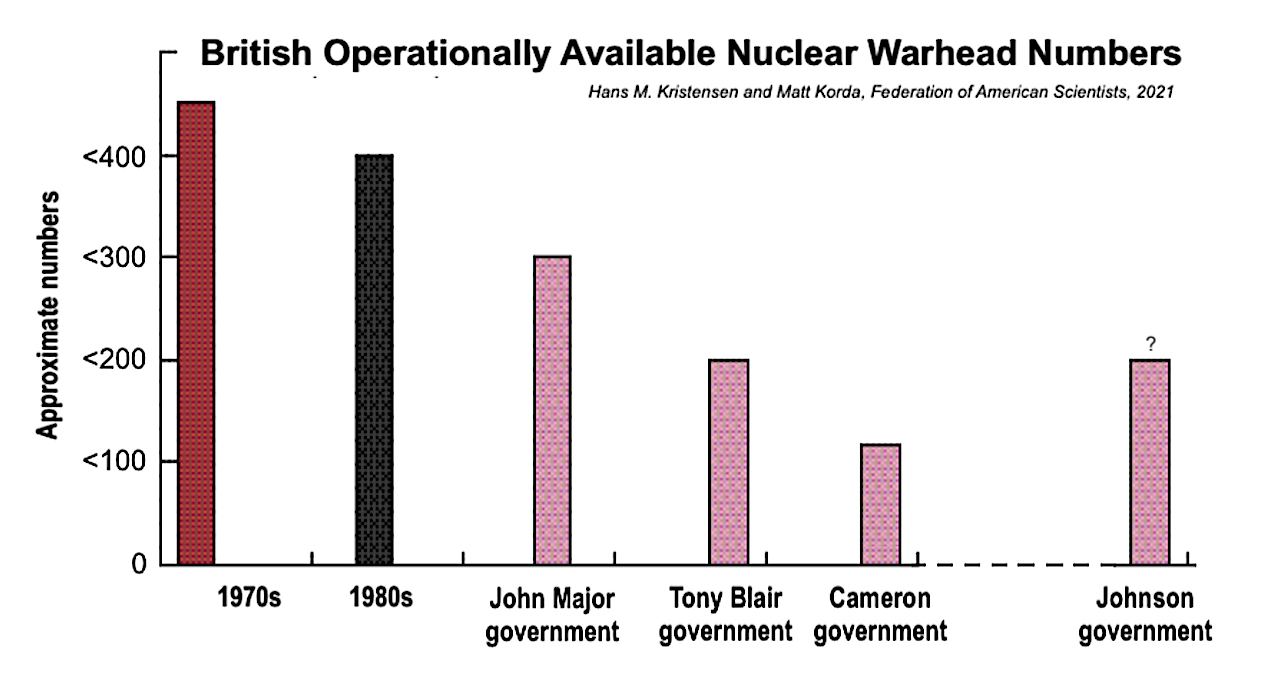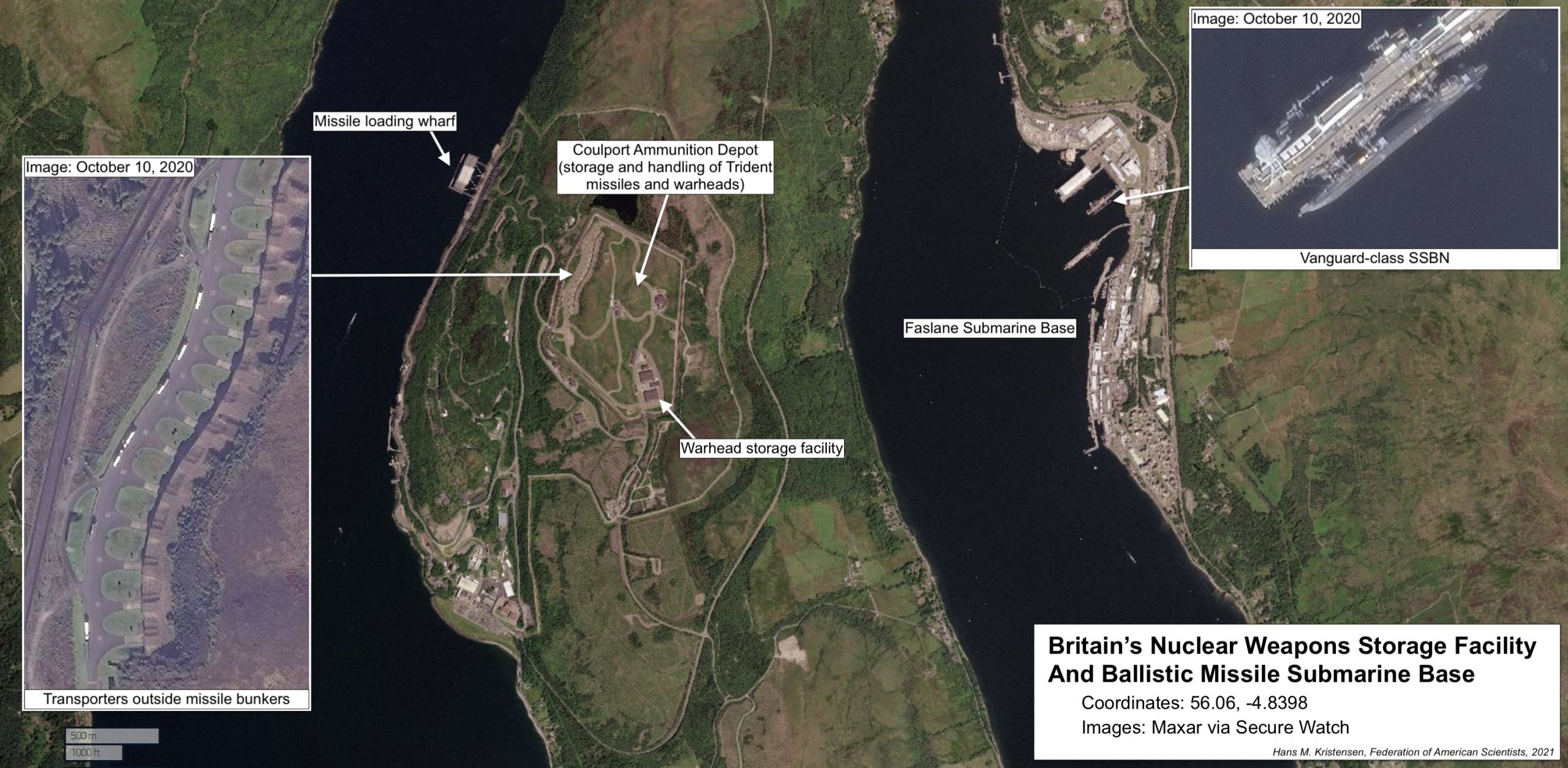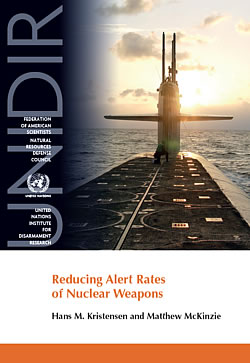Planning for the Unthinkable: The targeting strategies of nuclear-armed states
This report was produced with generous support from Norwegian People’s Aid.
The quantitative and qualitative enhancements to global nuclear arsenals in the past decade—particularly China’s nuclear buildup, Russia’s nuclear saber-rattling, and NATO’s response—have recently reinvigorated debates about how nuclear-armed states intend to use their nuclear weapons, and against which targets, in what some describe as a new Cold War.
Details about who, what, where, when, why, and how countries target with their nuclear weapons are some of states’ most closely held secrets. Targeting information rarely reaches the public, and discussions almost exclusively take place behind closed doors—either in the depths of military headquarters and command posts, or in the halls of defense contractors and think tanks. The general public is, to a significant extent, excluded from those discussions. This is largely because nuclear weapons create unique expectations and requirements about secrecy and privileged access that, at times, can seem borderline undemocratic. Revealing targeting information could open up a country’s nuclear policies and intentions to intense scrutiny by its adversaries, its allies, and—crucially—its citizens.
This presents a significant democratic challenge for nuclear-armed countries and the international community. Despite the profound implications for national and international security, the intense secrecy means that most individuals—not only including the citizens of nuclear-armed countries and others that would bear the consequences of nuclear use, but also lawmakers in nuclear-armed and nuclear umbrella states that vote on nuclear weapons programs and policies—do not have much understanding of how countries make fateful decisions about what to target during wartime, and how. When lawmakers in nuclear-armed countries approve military spending bills that enhance or increase nuclear and conventional forces, they often do so with little knowledge of how those bills could have implications for nuclear targeting plans. And individuals across the globe do not know whether they live in places that are likely to be nuclear targets, or what the consequences of a nuclear war would be.
While it is reasonable for governments to keep the most sensitive aspects of nuclear policies secret, the rights of their citizens to have access to general knowledge about these issues is equally valid so they may know about the consequences to themselves and their country, and so that they can make informed assessments and decisions about their respective government’s nuclear policies. Under ideal conditions, individuals should reasonably be able to know whether their cities or nearby military bases are nuclear targets and whether their government’s policies make it more or less likely that nuclear weapons will be used.
As an organization that seeks to empower individuals, lawmakers, and journalists with factual information about critical topics that most affect them, the Federation of American Scientists—through this report—aims to help fill some of these significant knowledge gaps. This report illuminates what we know and do not know about each country’s nuclear targeting policies and practices, and considers how they are formulated, how they have changed in recent decades, whether allies play a role in influencing them, and why some countries are more open about their policies than others. The report does not claim to be comprehensive or complete, but rather should be considered as a primer to help inform the public, policymakers, and other stakeholders. This report may be updated as more information becomes available.
Given the secrecy associated with nuclear targeting information, it is important at the outset to acknowledge the limitations of using exclusively open sources to conduct analysis on this topic. Information in and about different nuclear-armed states varies significantly. For countries like the United States—where nuclear targeting policies have been publicly described and are regularly debated inside and outside of government among subject matter experts—official sources can be used to obtain a basic understanding of how nuclear targets are nominated, vetted, and ultimately selected, as well as how targeting fits into the military strategy. However, there is very little publicly available information about the nuclear strike plans themselves or the specific methodology and assumptions that underpin them. For less transparent countries like Russia and China—where targeting strategy and plans are rarely discussed in public—media sources, third-country intelligence estimates, and nuclear force structure analysis can be used, in conjunction with official statements or statements from retired officials, to make educated assumptions about targeting policies and strategies.
It is important to note that a country’s relative level of transparency regarding its nuclear targeting policies does not necessarily echo its level of transparency regarding other aspects of its governance structure. Ironically, some of the most secretive and authoritarian nuclear-armed states are remarkably vocal about what they would target in a nuclear war. This is typically because those same countries use nuclear rhetoric as a means to communicate deterrence signals to their respective adversaries and to demonstrate to their own population that they are standing up to foreign threats. For example, while North Korea keeps many aspects of its nuclear program secret, it has occasionally stated precisely which high-profile targets in South Korea and across the Indo-Pacific region it would strike with nuclear weapons. In contrast, some other countries might consider that frequently issuing nuclear threats or openly discussing targeting policies could potentially undermine their strategic deterrent and even lower the threshold for nuclear use.
Delays, Deferment, and Continuous At-Sea Deterrence: The United Kingdom’s Increasing Nuclear Stockpile and the Infrastructure That Makes it Happen
Between 2006 and 2015, the United Kingdom repeatedly and publicly announced its intentions to decrease the size of its nuclear weapons stockpile, most recently committing to at most 180 weapons by the mid-2020s. As the years went by, non-government policy experts and nuke watchers assumed that the UK Government was making good on its word and that the UK nuclear arsenal would continue to gradually reduce. In reality, the United Kingdom is thought to have maintained a nuclear stockpile of approximately 225 weapons, and, in a surprise move in 2021, the United Kingdom declared that it would extend the ceiling of its “overall nuclear weapon stockpile” to no more than 260 weapons. This constituted an abrupt about-face from its previous commitments and trajectory.
However, the infrastructure underpinning the sustainability of the United Kingdom’s nuclear weapons and their modernization has experienced significant budgetary and scheduling challenges. Furthermore, the UK has dramatically reduced the public transparency of its nuclear forces, making it increasingly difficult to understand and debate the true scope of these challenges.
The UK’s Nuclear Warhead Modernization
Announced in 2005, the Atomic Weapons Establishment’s (AWE) Nuclear Warhead Capability Sustainment Programme (NWCSP) was an initiative to deliver infrastructure and technology to sustain the United Kingdom’s current stockpile and underpin its warhead replacement program. Each of these main infrastructure and technology projects is named after a constellation: Project Orion for a high-power research laser that began operations in 2013, Project Leo for a small parts manufacturing facility, Project Pegasus for the manufacturing of uranium components effort, and so on. Several of these projects under the NWCSP related to techniques used for nuclear weapons development in place of explosive testing. Part of the NWCSP mission also involved refurbishing the United Kingdom’s current warheads for integration with the U.S.-supplied, upgraded Mk4A aeroshell, which was completed in 2023. The NWCSP was scheduled to run from April 2008 until April 2025 and was removed from the MOD Government Major Projects Portfolio data starting in 2022, indicating it could have been downsized from a large-scale development initiative.
In February 2020, the UK defence secretary announced a new warhead program—the A21/Mk7/ Astraea. This new warhead is currently in the concept stage but is planned to eventually replace the Mk4A/Holbrook beginning in the late 2030s. As was the case with the previous version, the A21/Mk7 Astraea design and production will have a “very close connection” to the future US W93/Mk7.
In 2023, the MOD confirmed that £127 million had been spent on the A21 Astraea warhead replacement program as of March 2022. The total cost of the replacement program has not been released, given it is still in the early stages. However, even if cumulative costs are released, individual costs associated with the warhead modernization program will be challenging to identify due to changes in UK budgetary reporting practices. In 2023, nuclear-related programs and expenditures—including the AWE and the NWCSP—were compiled into one heading under Defence Nuclear Enterprise (DNE), which appears as a single line item in the departmental estimates. This makes it impossible to see the direct in-service costs associated with the individual programs. DNE funding was also “ringfenced” within the MOD budget to protect it against spending cuts.
The UK’s declaration that its stockpile ceiling will be raised to 260 raises several questions. In the early- to mid-2000s, the United Kingdom possessed a stockpile of roughly 280 warheads, but in 2010 announced it would reduce this level to “no more than 225 warheads.” To be able to increase this level to up to 260 warheads, as announced by the UK government in 2021, it seems some of the retired warheads—or components from them—must have been retained in some form. The United Kingdom appears to use the term “stockpile” to describe operational, deployed, and retired weapons. The timeline for potentially increasing the stockpile to up to 260 is not known, but if it is a relatively short timeline, it would seem to require reconstituting some retired warheads. If it is a longer timeline, it could potentially involve increasing the number of A21 Astraea warheads in the future. Of the “no more than 225” warhead stockpile level, the United Kingdom has previously explained that 120 warheads would be operationally available, of which 40 would be deployed on the single ballistic missile submarine (SSBN) on patrol at all times. The reason for increasing the stockpile to up to 260 warheads appears to be derived from an interest in increasing the number of “operationally available” warheads to be able to deploy a full warhead load on the SSBN fleet—something the recent warhead level did not allow.
Critical Infrastructure
Any warhead design, manufacturing, and testing occurs at the AWE site at Aldermaston while the warheads are assembled, maintained, and decommissioned at AWE Burghfield. These two sites are critical to maintaining the United Kingdom’s existing stockpile and will play a significant role in the new warhead replacement program.
Upgrades at AWE Burghfield
Project MENSA—one of the infrastructure programs under the NWCSP—aims to consolidate existing nuclear warhead assembly and disassembly operations into a single building located in the center of the AWE Burghfield complex called the Main Processing Facility (MPF). MENSA will replace the existing Gravel Gertie bunkers used for warhead assembly and disassembly on the eastern part of the campus, which are designed to collapse inward in the event of an explosion. Other new infrastructure for this project includes a support building and 16 lightning protector towers to accompany the MPF, as well as an associated plant building, gatehouses, vehicle inspection bays, substation buildings, security fences, access roads, and Sustainable Drainage System (SuDS) infrastructure.
Project MENSA’s completion has been delayed by more than seven years, and its expected cost is £1.36 billion over its original total budget of £0.8 billion. Construction progress at the site can be observed through satellite imagery and should be nearing completion of construction according to the MoD’s 2024 Major Project Portfolio data.

Upgrades at AWE Aldermaston
AWE Aldermaston, where warhead design, development, manufacturing, assembly, and testing occur, is also undergoing significant upgrades and revitalization. In 2024, AWE announced two new infrastructure programs—the Future Infrastructure Programme (FIP) for general infrastructure and the Future Materials Campus (FMC) for nuclear material manufacturing and storage—to consolidate existing programs and invest in new ones to increase capacity for maintaining, manufacturing, and storing nuclear weapons. The procurement process for these multi-year, multi-billion pound projects began on April 22 and December 12, 2024, respectively. The FMC, in particular, will be a collection of facilities, including nuclear science and technology centers and laboratories, to be built at AWE Aldermaston. This program will replace two major projects that initially fell under the NWCSP—Project Pegasus and Project Aurora.
Project Pegasus was described as a new enriched uranium storage and manufacturing facility at AWE Aldermaston that would replace the existing enriched uranium handling facility located at the A45 building. Work began in 2003, and the original projected service date was 2016. The approved cost was originally £634 million before it skyrocketed to £1.7 billion. After a six-year delay and a three-year pause, construction of the new storage facility began, and the manufacturing facility was scheduled to be finished by 2030. The severe delays were mainly due to challenges with the supply chain environment and an “overly complex technical solution” that resulted in additional construction and safety costs and a “reassessment” of the project design and requirements.
The UK government was also in the early design phase of Project Aurora, an infrastructure project for a new plutonium manufacturing facility that would replace the current A90 building at AWE Aldermaston. This program was experiencing delays due to resourcing problems, supply chain shortages, and high-skilled workforce challenges. Project Aurora was removed from the NWCSP and added as an independent program to the MOD’s Major Projects Portfolio in 2022. Projects Aurora and Pegasus were both removed from the 2024 version of the MOD’s Major Projects Portfolio database, likely due to their absorption into the new FMC program.
The other central element of NWCSP is the delivery of a new hydrodynamics facility. In 2010, the United Kingdom and France signed the Teutates Treaty, which allowed for cooperation on warhead physics research between the two nations. From this agreement, the EPURE radiographic facility was built at Valduc in France, and a joint UK-France Technology Development Centre was established at Aldermaston. These facilities will support hydrodynamic research that will allow the study of the effects of aging and manufacturing processes on nuclear warheads without nuclear explosive testing. Because of the Teutates program, the UK’s original plans for a ‘Project Hydrus’ hydrodynamics facility were canceled.

Outstanding Challenges
The facilities described above are deemed crucial to the United Kingdom’s effort to modernize and refurbish its nuclear deterrent. However, the significant delays and cost overruns have elicited criticism from the public and concern from government authorities over the years. In August 2024, the House of Commons reported a spending deficit on nuclear programs across the Defence Equipment Plan. Over the next ten years (2023 to 2033), costs are forecasted at £117.8 billion, of which only £109.8 billion had been budgeted for when the report was released.
Alongside these warhead development and infrastructure programs, the United Kingdom is also replacing its four SSBNs with the new Dreadnaught class, the first of which is expected to enter service in the early 2030s. This modernization has also been plagued by cost increases and threatens to be delayed, given maintenance issues with the existing fleet.
Moreover, the recent decrease in UK government transparency regarding the status of its nuclear arsenal and modernization program reflects a worrisome global trend. The United Kingdom has not publicly declared the approximate size of its stockpile since 2010, following the Obama Administration’s decision to release its stockpile number. In 2021, the MOD referred to the 2010 announcement again but did not explicitly say what the stockpile number was. Moreover, it said it would “no longer give public figures for our operational stockpile, deployed warhead or deployed missile numbers.”
Additionally, the MOD said in 2023 that it was withholding information on planned in-service dates for many of the above-referenced projects for “reasons of national security” and did not release this information in its 2022, 2023, and 2024 Major Projects Portfolio data. Finally, the MOD has published an annual update to Parliament since 2011 on the progress of nuclear weapons upgrades, but there has been no report published for 2023 or 2024.
While some of this backsliding is likely rooted in concerns about public perception of persistent programmatic delays, the overall picture raises concerns about a pattern of declining transparency and reduced public ability to monitor and hold the UK government accountable for its nuclear weapons program.
Reawakening a Nuclear Legacy: The Potential Return of the US Nuclear Mission to RAF Lakenheath
In the spring of 2022, researchers at the Federation of American Scientists began reading newly released U.S. Defense Department budget documents to look for updates concerning the Pentagon’s priorities for the next fiscal year. As the researchers poured over hundreds of pages, two words suddenly captured their attention: the Biden administration’s Fiscal Year (FY) 2023 budget request had added “the UK” to a list of countries receiving upgrades to their “special weapons” storage sites under a 13-year NATO investment program. The term “special weapons” is often used by the U.S. government when referring to nuclear weapons. However, the United States has not deployed nuclear weapons in the United Kingdom for nearly two decades. Those two words sparked dozens of questions, years of continued research, and a new local movement of protests against the return of a potential nuclear mission to RAF Lakenheath.
This new report provides an account of the nuclear history of RAF Lakenheath and the role it played in the US nuclear mission until nuclear weapons were withdrawn in 2008. The report then explains the mounting evidence from three years of collection of documentation and observations that show the United States Air Force is re-establishing its nuclear mission on UK soil for the first time in nearly two decades.
As of February 2025, there are no known public indications that nuclear weapons have been deployed to RAF Lakenheath – we assess that the return of the nuclear mission is intended primarily as a backup rather than to deploy weapons now. However, if this were to happen, it would break with decades of policy and planning and reverse the southern focus of the European nuclear deployment that emerged after the end of the Cold War. Even without weapons present, the addition of a large nuclear air base in northern Europe is a significant new development that would have been inconceivable just a decade-and-a-half ago.
The authors would like to thank Matt Korda and Kate Kohn for their invaluable contributions to this report, as well as the Joseph Rowntree Charitable Trust for their support.
Federation of American Scientists Releases Latest United Kingdom Edition of Nuclear Notebook
Washington, D.C. – November 12, 2024 – The United Kingdom is modernizing its stockpile of nuclear weapons and delivery systems, as detailed today in the Federation of American Scientists latest edition of its Nuclear Notebook, “United Kingdom Nuclear Forces, 2024”. The researchers estimate that the United Kingdom has maintained its stockpile of 225 nuclear warheads and predict an eventual increase based on shifting posture to counter Russia, modernization, and alliance efforts. The Notebook is published in the Bulletin of the Atomic Scientists and available here.
“Budget overruns remain a constraint for the UK nuclear modernization program, significant parts of which are done in close collaboration with the United States, and efforts are underway to expand the nuclear warhead stockpile,” observes Hans Kristensen, Director of the FAS Nuclear Information Project and one of the Nuclear Notebook authors.
Modernization and nuclear infrastructure construction
The United Kingdom is replacing its sole nuclear platform––the aging Vanguard-class ballistic missile submarines (SSBNs)––with the new Dreadnought-class that is currently under construction.
Additionally, the FAS report includes satellite imagery of ongoing construction at the Atomic Weapons Establishment (AWE) facilities at Aldermaston and Burghfield, including a new warhead assembly facility, enriched uranium storage facility, and plutonium manufacturing facility.
Challenges for the future
Budget overruns and delays in construction continue to be one of the biggest issues for the United Kingdom’s nuclear program. Projected costs for the UK Navy have gone up by 41 percent due to the Dreadnought SSBN program. Delays in this program could threaten the Navy’s ability to maintain their Continuous At-Sea Deterrent (CASD), as it would put additional stress on the Vanguard fleet that has already been pushed past its service life. Nuclear infrastructure projects, including the MENSA warhead facility, are also behind schedule and over-budget.
Collaboration with the United States
Upgrades at RAF Lakenheath discovered by the Notebook authors signal the return of the United States Air Force nuclear mission to the United Kingdom, although it is unlikely that US nuclear weapons will be permanently stored on UK soil in peacetime. The arrival of the F-35A Lightning II, capable of carrying B61-12 gravity bombs, US budgetary indicators for special storage upgrades, and the construction of a new “surety” dormitory for US Airmen at RAF Lakenheath all indicate preparations for the potential return of US nuclear weapons which have been absent in the United Kingdom since 2008.
The Notebook also outlines cooperation between the UK and US Navy on missile tests. This year, UK ballistic missile submarines conducted test fires off the coast of Cape Canaveral, Florida, and US laboratories evaluated and provided measurements for the test effort.
###
ABOUT THE NUCLEAR NOTEBOOK
The FAS Nuclear Notebook, co-authored by Hans M. Kristensen, Matt Korda, Eliana Johns, and Mackenzie Knight, is an effort by the Nuclear Information Project team published bi-monthly in the Bulletin of the Atomic Scientists. The joint publication began in 1987. FAS, formed in 1945 by the scientists who developed the nuclear weapon, has worked since to increase nuclear transparency, reduce nuclear risks, and advocate for responsible reductions of nuclear arsenals and the role of nuclear weapons in national security.
This latest issue follows the release of the 2024 India Nuclear Notebook. The next issue will focus on the United States. More research is located at FAS’s Nuclear Information Project.
The Federation of American Scientists’ work on nuclear transparency would not be possible without generous support from the Carnegie Corporation of New York, Longview Philanthropy, the Joseph Rowntree Charitable Trust, the Jubitz Family Foundation, the New-Land Foundation, Ploughshares, the Prospect Hill Foundation, and individual donors.
ABOUT FAS
The Federation of American Scientists (FAS) works to advance progress on a broad suite of contemporary issues where science, technology, and innovation policy can deliver dramatic progress, and seeks to ensure that scientific and technical expertise have a seat at the policymaking table. Established in 1945 by scientists in response to the atomic bomb, FAS continues to work on behalf of a safer, more equitable, and more peaceful world.
NATO Steadfast Noon Exercise And Nuclear Modernization in Europe
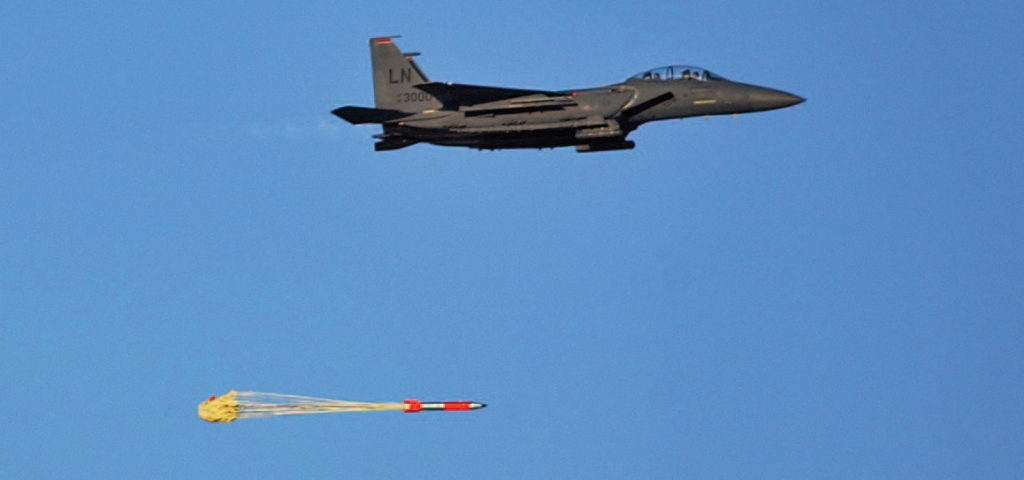
The Steadfast Noon exercise will practice employment of non-strategic nuclear weapons, like this unarmed B61-4 nuclear gravity bomb dropped by an F-15E from the 48th Fighter Wing at RAF Lakenheath. Image: Sandia National Laboratories.
[Updated version] Today, Monday October 17, 2022, the North Atlantic Treaty Organization (NATO) will begin a two-week long exercise in Europe to train aircrews in using U.S. non-strategic nuclear bombs. The exercise, known as Steadfast Noon, is centered at Kleine Brogel Air Base in Belgium, one of six airbases in Europe that store U.S. nuclear bombs. The exercise takes place midst significant modernizations at nuclear bases across Europe.
Steadfast Noon exercises are held once every year, but this year is unique because the exercise will take place during the largest conventional war in Europe since World War II with considerable tension and uncertainty resulting from Russia’s war in Ukraine. Moreover, Steadfast Noon is expected to more or less coincide with a large Russian strategic nuclear exercise. For NATO officials, other than Putin’s war in Ukraine, this is all routine. But for the public, it is but the latest development in rising tensions and unprecedented fears about nuclear war.
According to NATO, Steadfast Noon will involve 14 countries (less than half of the 30 NATO allies) and up to 60 aircraft. That involves fourth-generation F-16s and F-15Es as well as fifth-generation F-35A and F-22 fighter jets. A number of tankers and surveillance aircraft will also take part. Although the exercise is practicing NATO’s non-strategic nuclear forces, a couple of U.S. strategic B-52 bombers will also participate. Training flights will take place over Belgium and the United Kingdom as well as over the North Sea. There might also be flights over Germany and the Netherlands.
Practicing Nuclear Bomb Sharing
The Steadfast Noon exercise will practice a controversial arrangement known as nuclear sharing, under which the United States installs nuclear equipment on fighter jets of select non-nuclear NATO countries and train their pilots to carry out nuclear strike with U.S. nuclear bombs.
The arrangement is controversial because the United States as a party to the nuclear Non-Proliferation Treaty (NPT) has promised not to hand over nuclear weapons to other countries, and the non-nuclear countries in the sharing arrangement have promised not to receive nuclear weapons from the nuclear weapon states. In peacetime the nuclear weapons are under U.S. control, but the arrangement means that they would be handed over to the non-nuclear country in war time. The arrangement was in place before the NPT was signed so it is not a violation of the letter of the treaty. But it can be said to violate the spirit and has been an irritant for years.
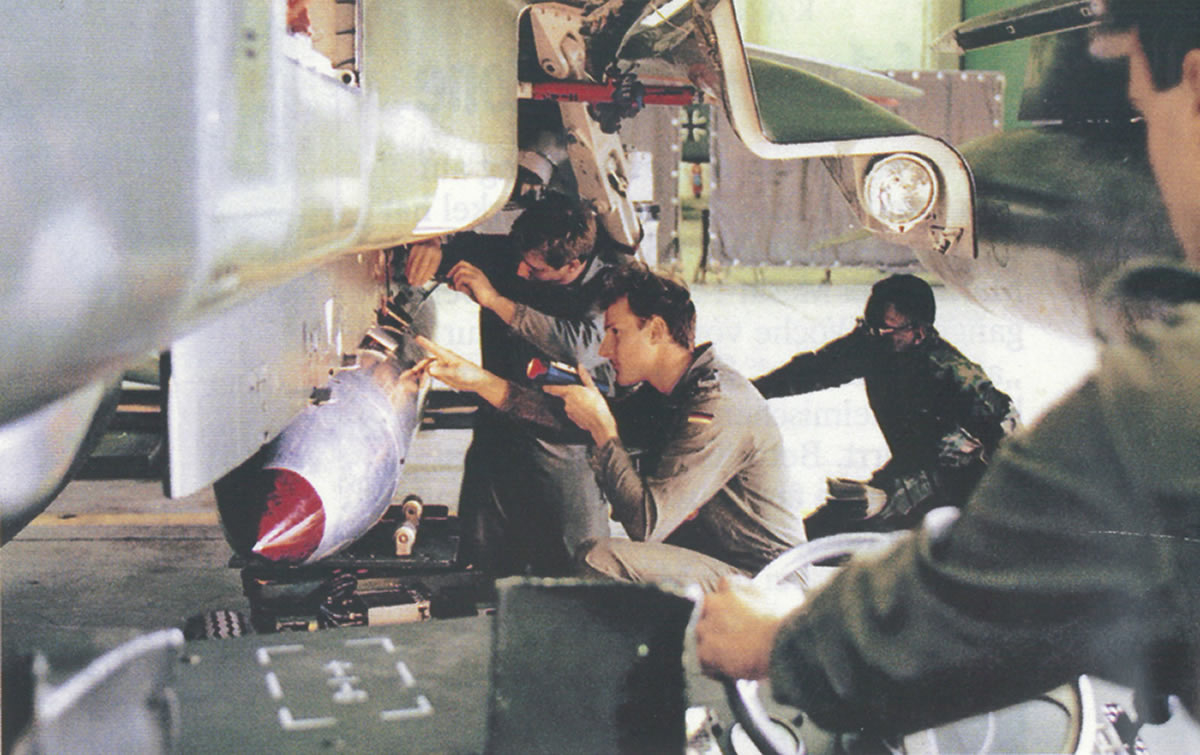
Under supervision by U.S. Air Force personnel, German Air Force personnel is practicing loading of a U.S. B61-4 nuclear bomb shape on a German Tornado fighter jet. In a war, German pilots could be given control of U.S. nuclear bombs. Image: Der Spiegel.
“If NATO was to conduct a nuclear mission in a conflict,” NATO says, “the B-61 [sic] weapons would be carried by certified Allied aircraft…However, a nuclear mission can only be undertaken after explicit political approval is given by NATO’s Nuclear Planning Group (NPG) and authorisation is received from the US President and UK Prime Minister.” It is unclear why the U.K. Prime Minister would have to authorize employment of U.S. nuclear weapons, and unless NATO territory had been attacked with nuclear weapons first, it seems unlikely that the 29 countries in the NPG would be able to agree to approve of employment of non-strategic nuclear weapons from bases in Europe.
NATO disclosed earlier this year that seven NATO countries contribute dual-capable aircraft to the nuclear sharing mission. The countries were not identified but five are widely known: Belgium, Germany, Italy, Netherlands, and the United States. The sixth country is probably Turkey (despite rumors that it was no longer part of the mission), in which case some Turkish F-16s are still equipped to deliver B61 bombs. The seventh country was a mystery, but it turns out it is Greece. Although Greece no longer stores nuclear weapons (they were withdrawn in 2001) and doesn’t have a committed fighter unit, it has a reserve units and a contingency mission. Like other allies (except France), Greece is fully involved in the NPG.]
Nuclear Base Modernizations
During the past several years, the nuclear bases and the infrastructure that support the nuclear sharing mission in Europe have been undergoing significant upgrades, including cables, command and control systems, weapons maintenance and custodial facilities, security perimeters, and runway and tarmac areas.
There are currently six active sites in Europe that store U.S. nuclear bombs: Kleine Brogel air base in Belgium, Büchel air base in Germany, Aviano and Ghedi air bases in Italy, Volkel air base in the Netherlands, and possibly Incirlik in Turkey. The estimated number of weapons at each site is based on the number of active vaults, aircraft, and other information.
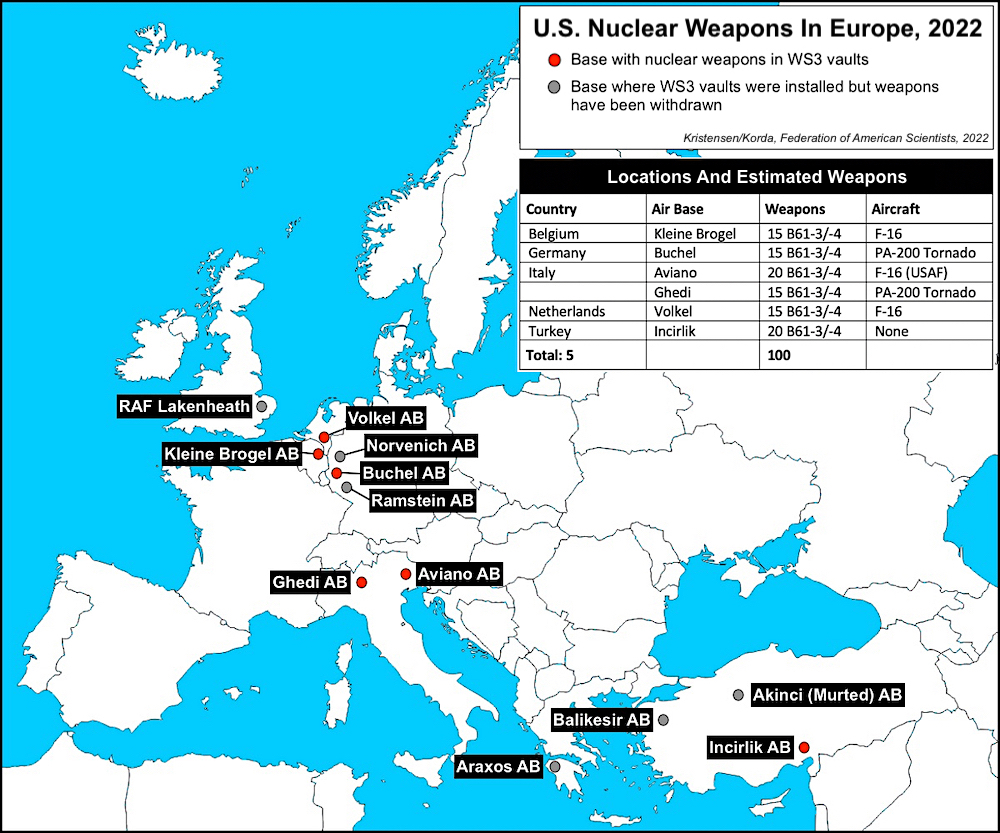
Each of these bases have one or two dozen active vaults (Weapons Storage Security System, WS3) inside as many protective aircraft shelters. Ramstein air base in Germany used to be the largest storage site in Europe but only 7 vaults remain active possibly for training and transfer. All weapons were withdrawn from Lakenheath before 2007 but the United Kingdom was recently added to the nuclear infrastructure storage modernization program, which means there are now eight active WS3 sites in Europe.

The modernizations at the various bases vary depending on capacity, location, and host country. At Kleine Brogel Air Base in Belgium, the host base for the Steadfast Noon exercise this year, the 701st Munition Support Squadron quarters have been significantly expanded with a drive-through facility for nuclear weapons maintenance trucks. Other construction includes a major facility inside the aircraft tarmac perimeter area, a new control tower, and upgrades of underground cables and the Alarm Communication & Display (AC&D) system.
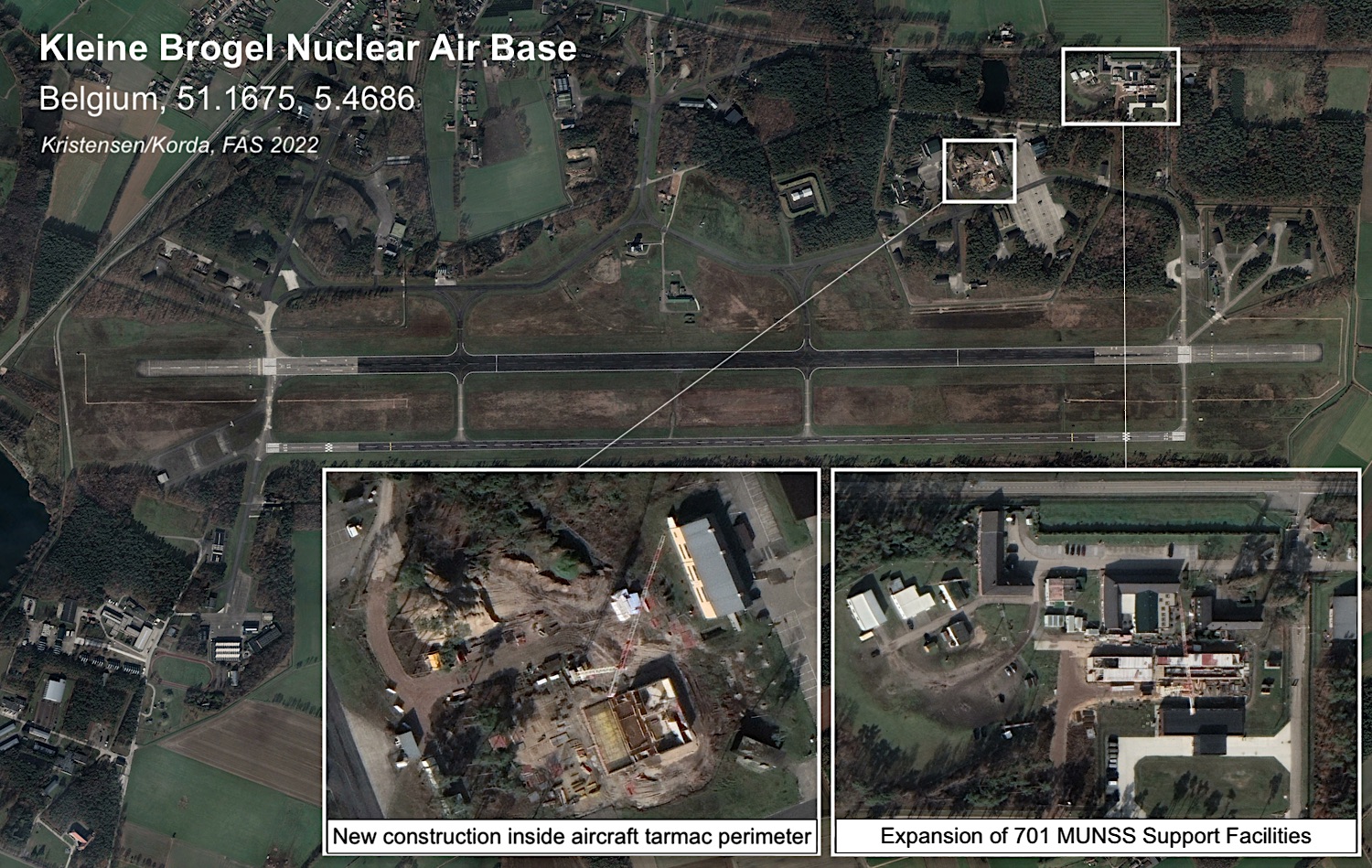
At Büchel Air Base in Germany, construction is underway on the runway. During construction, the Tornados of the 33rd Fighter Wing will be temporarily based at Norvenich Air Base. However, the 10-15 B61 nuclear bombs will remain in the vaults at Büchel. Other recent updates at the base have included underground cables and the Alarm Communication & Display (AC&D) system.
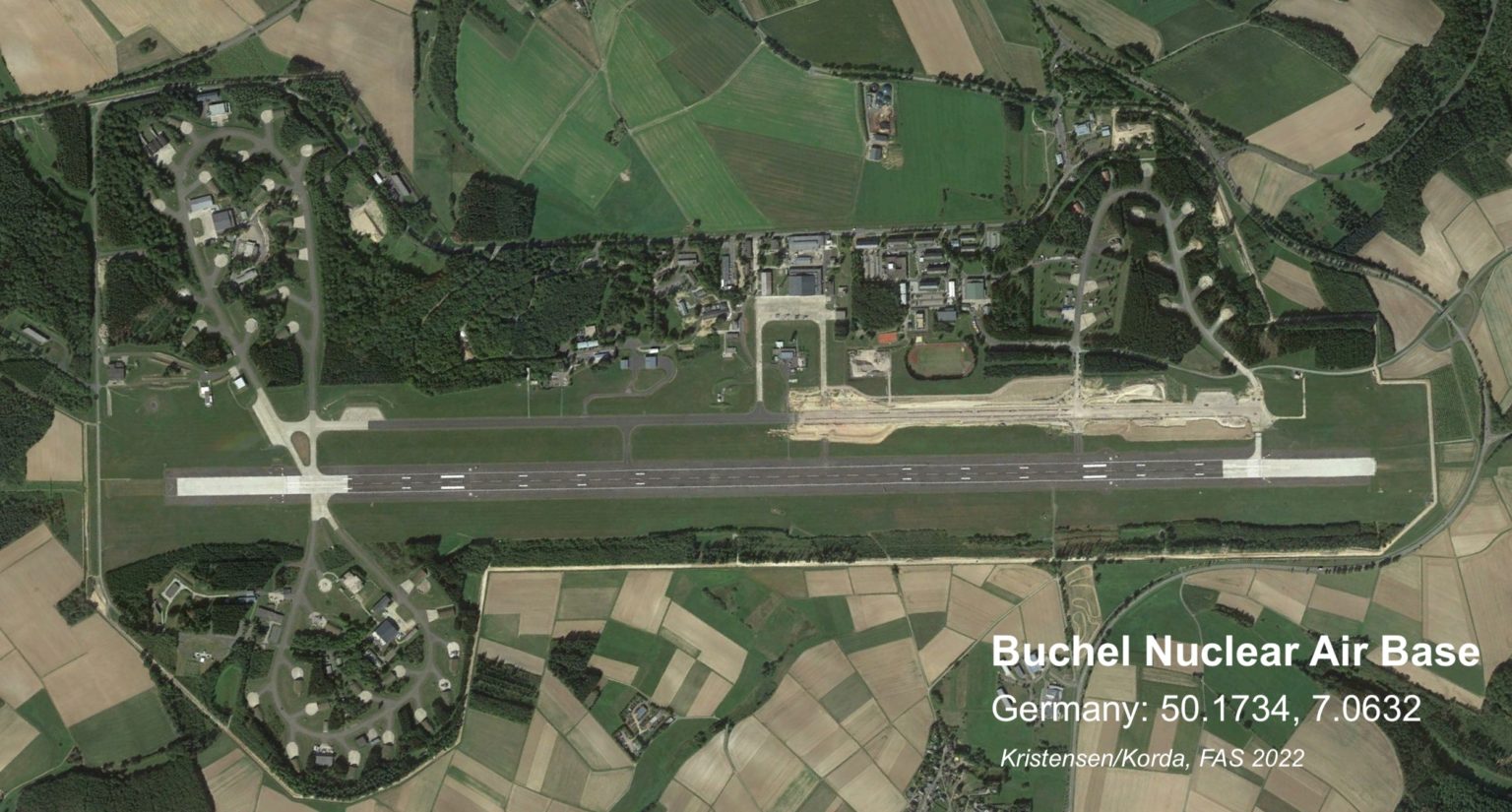
In 2020, as part of a series of visits to bases involved in the nuclear sharing mission, U.S. Air Force Maj. Gen. Derek C. France, the director of operations, strategic deterrence, and integration for U.S. Air Forces in Europe – Air Forces Africa Headquarters director of operations, strategic deterrence, and integration, visited Büchel Air Base where he received a tour and explanation of a protective aircraft shelter. A picture of the tour shows the vault open and a B61 nuclear bomb shape inside.
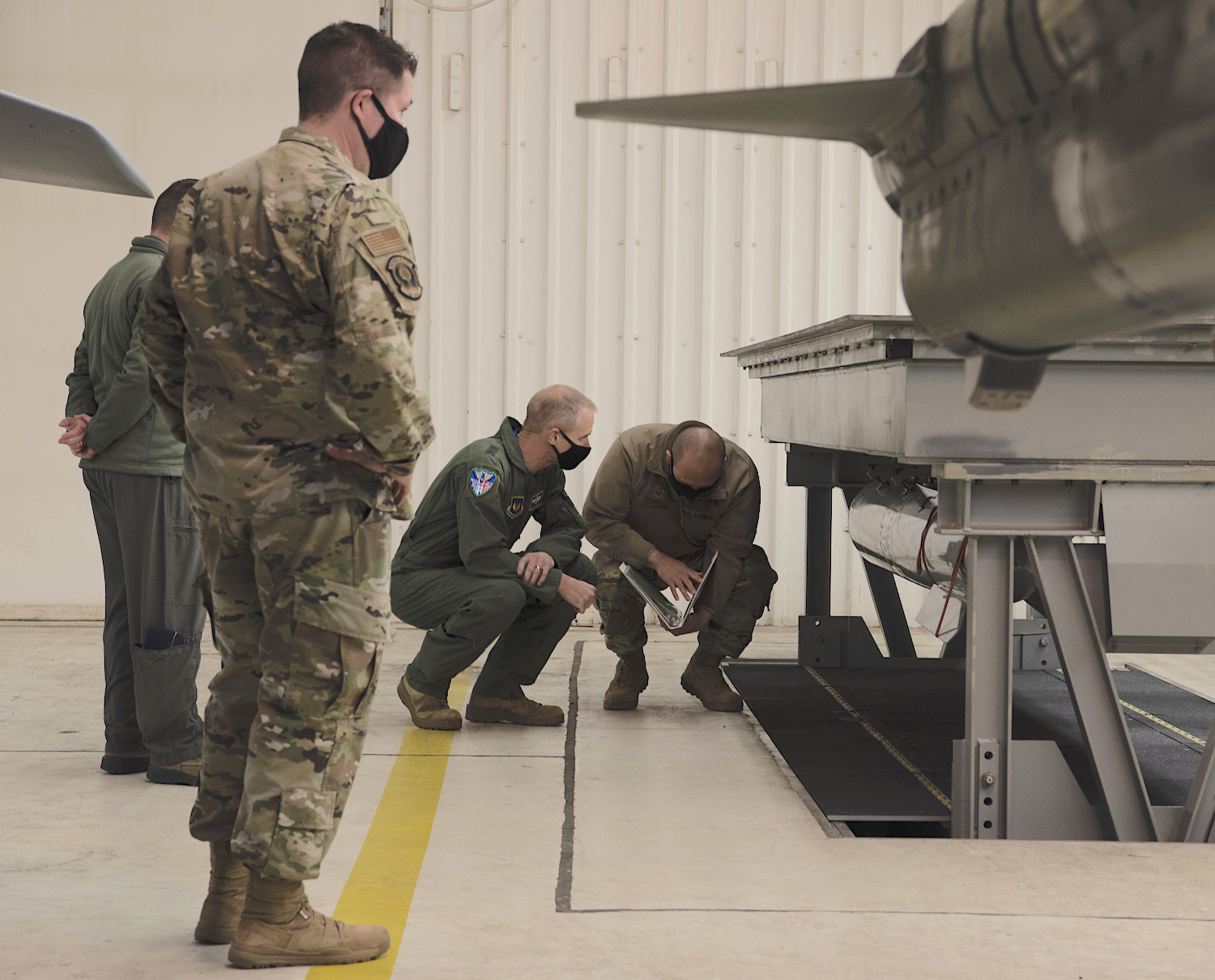
U.S. Air Force Maj. Gen. Derek C. France, U.S. Air Forces in Europe – Air Forces Africa Headquarters director of operations, strategic deterrence, and nuclear integration, received a tour of a Protective Aircraft Shelter at Büchel Air Base on October 15, 2020. The image shows a B61 nuclear bomb shape hanging in the elevated vault.
At Volkel Air Base in the Netherlands, the most visible modernization currently underway is a major new tarmac area. The construction includes security perimeters probably intended to protect the C-17 aircraft that transport weapons and components to and from the base. Other recent construction the base has included burying underground cables and upgrading the Alarm Communication & Display (AC&D) system used for the WS3 vaults.
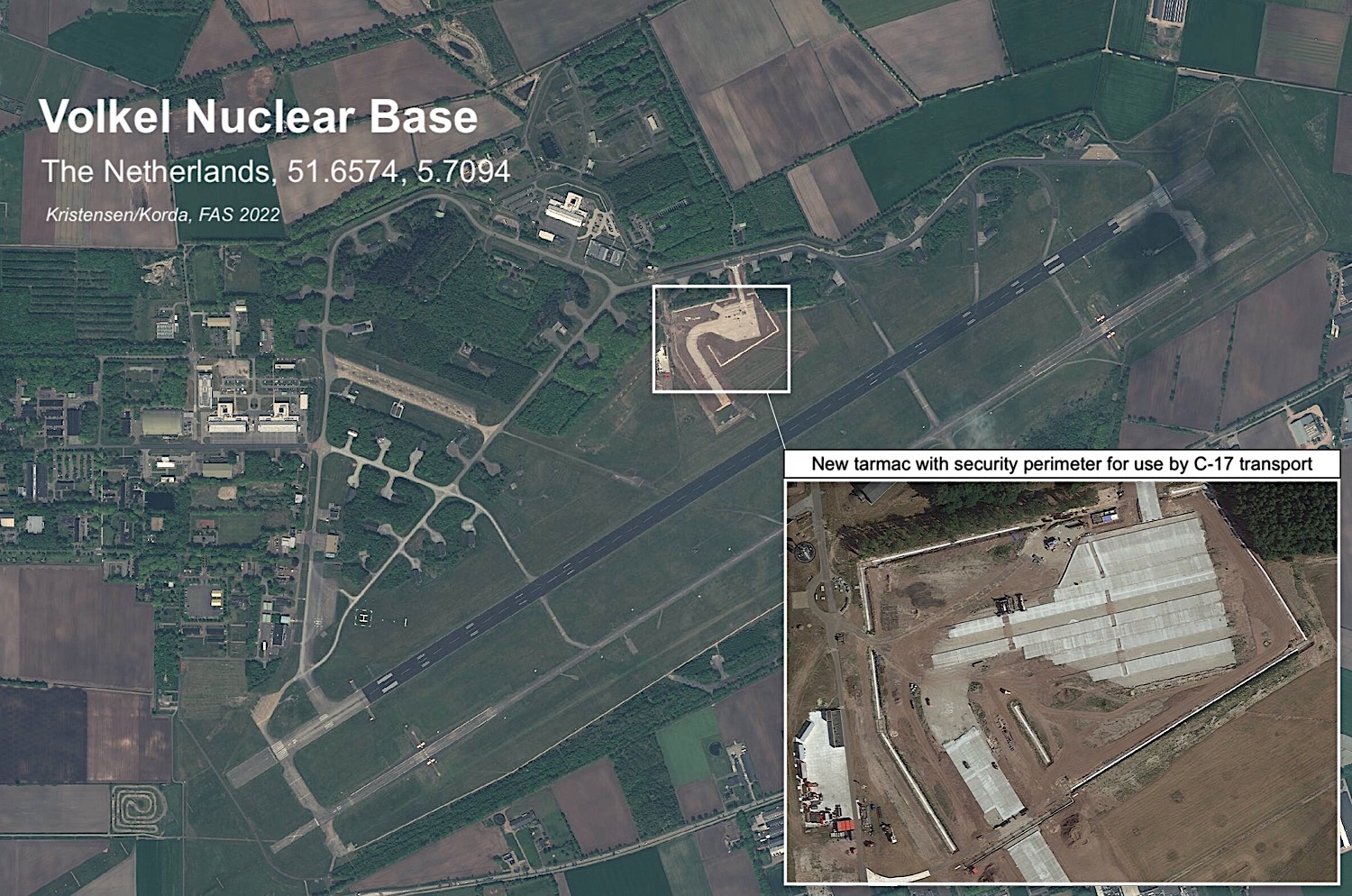
Ghedi Air Base in Italy is undergoing a dramatic upgrade that includes a new tarmac and shelter area for the new F-35A fighter jets that will replace the Tornado jets in the nuclear sharing mission. Work is also underway on what appears to be a drive-through facility for weapons maintenance trucks in the 704th MUNSS area. And a new high-security perimeter has been erected around eight vaults, possibly those of the 11 that are active. This perimeter is similar to perimeters that were constructed at Aviano and Incirlik air bases in 2014-2015. Finally, Ghedi also has received an upgrade of underground cables and the Alarm Communication & Display (AC&D) system used for the WS3 vaults.
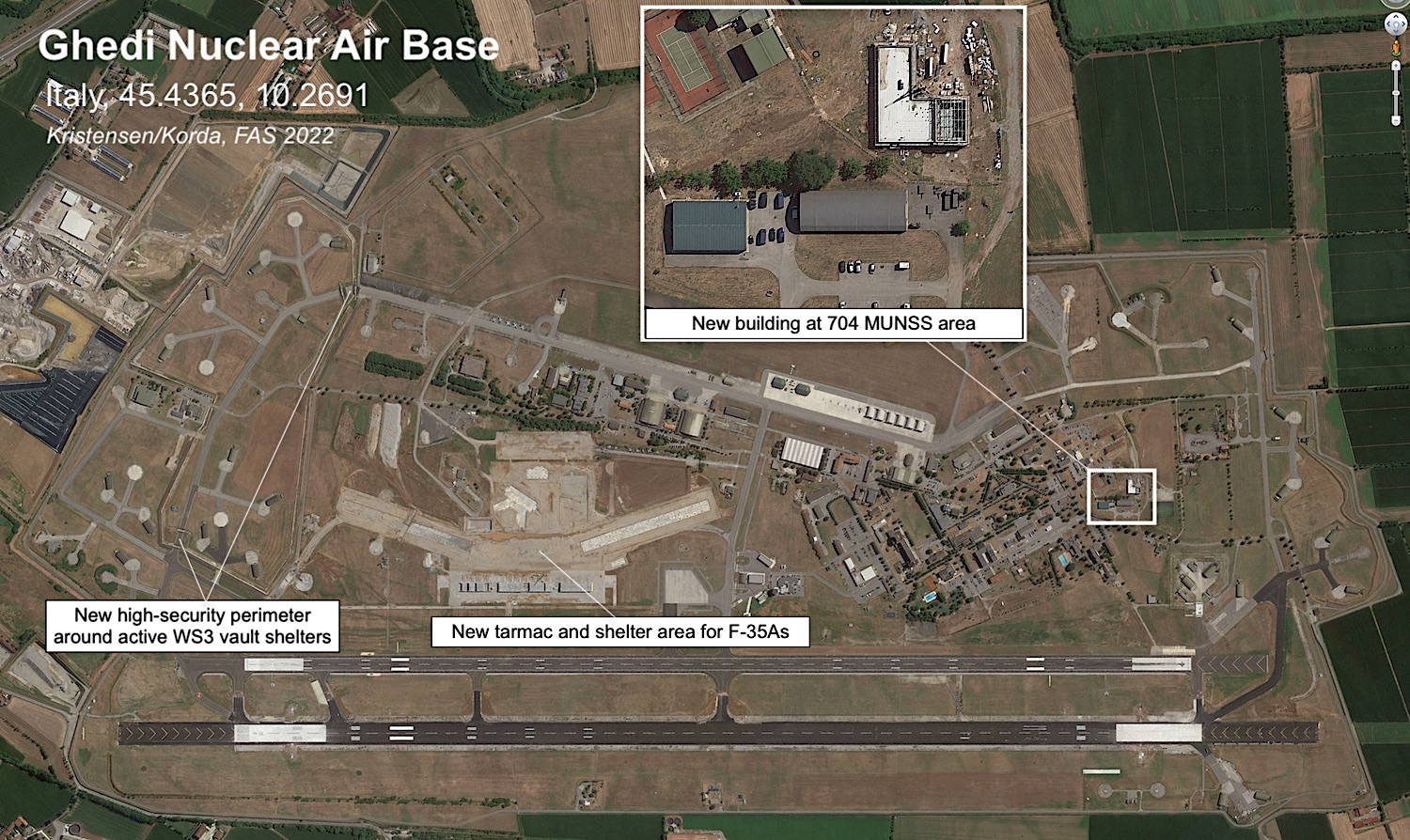
Upgrades of Aviano Air Base in Italy and Incirlik Air Base in Turkey happened around 2015 are described in this article: Upgrades At US Nuclear Bases In Europe Acknowledge Security Risk. Since then, installation of new cables between the nuclear vaults at Incirlik Air Base is visible on satellite images.

Weapons Modernization
In addition to modernization of bases and support facilities, delivery systems and weapons are also being upgraded. Five of the seven countries that contribute dual-capable aircraft to the nuclear sharing mission are upgrading to the F-35A fifth-generation fighter-bomber: Belgium, Germany, Italy, the Netherlands, and the United States. Turkey was scheduled to upgrade to F-35A but lost the contract after it purchased the Russian S-400 system.
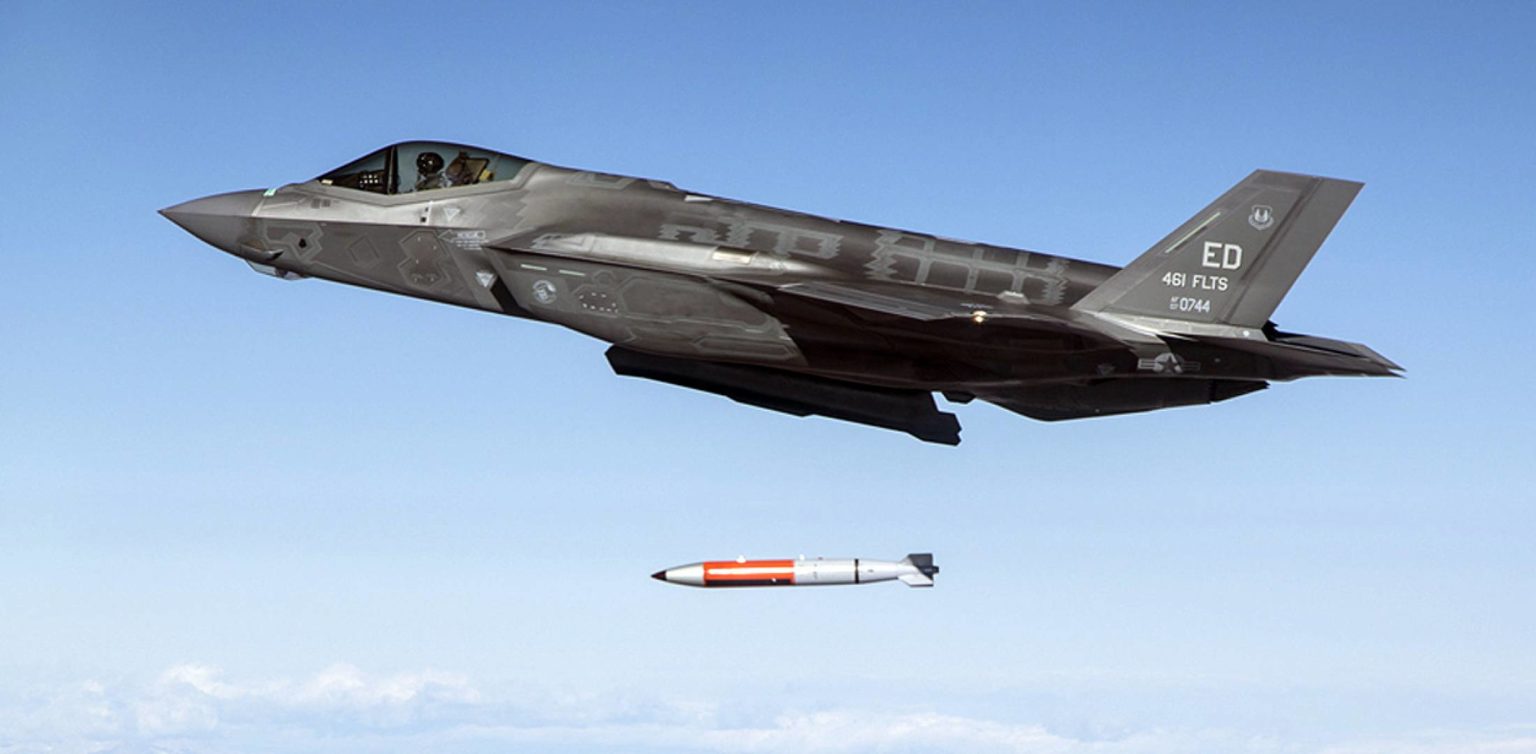
An F-35A test-drops a B61-12 guided nuclear bomb. The enhanced weapon will be compatible with both fighter jets and strategic bombers and begin replacing older B61 versions in Europe from 2023. Image: U.S. Air Force.
Finally, the existing B61 nuclear bombs will soon be replaced by the enhanced B61-12 guided nuclear bomb. Development is essentially complete and full-scale production of about 480 B61-12s is expected to begin soon. The new weapon is thought to have the same yield range as the current B61-4: 0.3, 1.5, 10 and 50 kilotons. Training of the units in Europe to receive the new weapon is scheduled to begin in early-2023 and the first weapons potentially arriving at the first base in late-2023 or 2024.
In addition to the non-strategic fighter jets F-15E, F-16, F-35A, and Tornado, the B61-12 will also be integrated on the B-2 and B-21 strategic bombers. Because of the increased accuracy provided by the tail kit, all the digital aircraft that can make use of it (all except F-16 and Tornado) will be able to hold at risk a wide range of targets. The combination of increased accuracy and lower-yield options on non-strategic and strategic stealth aircraft will significantly increase the capability of the gravity bomb mission.

Each of the WS3 vaults at European bases can hold up to four nuclear bombs. Here crews are practicing loading B61 bombs into a vault: two B61-3/4 bombs on the top rack and two B61-12 bombs on the lower rack. Image: U.S. Air Force, obtained by Joseph Trevithick (The Drive) under FOIA.
This publication was made possible by generous contributions from the John D. and Catherine T. MacArthur Foundation, the New-Land Foundation, the Ploughshares Fund, the Prospect Hill Foundation, Longview Philanthropy, the Stewart R. Mott Foundation, the Future of Life Institute, Open Philanthropy, and individual donors. The statements made and views expressed are solely the responsibility of the author.
Lakenheath Air Base Added To Nuclear Weapons Storage Site Upgrades
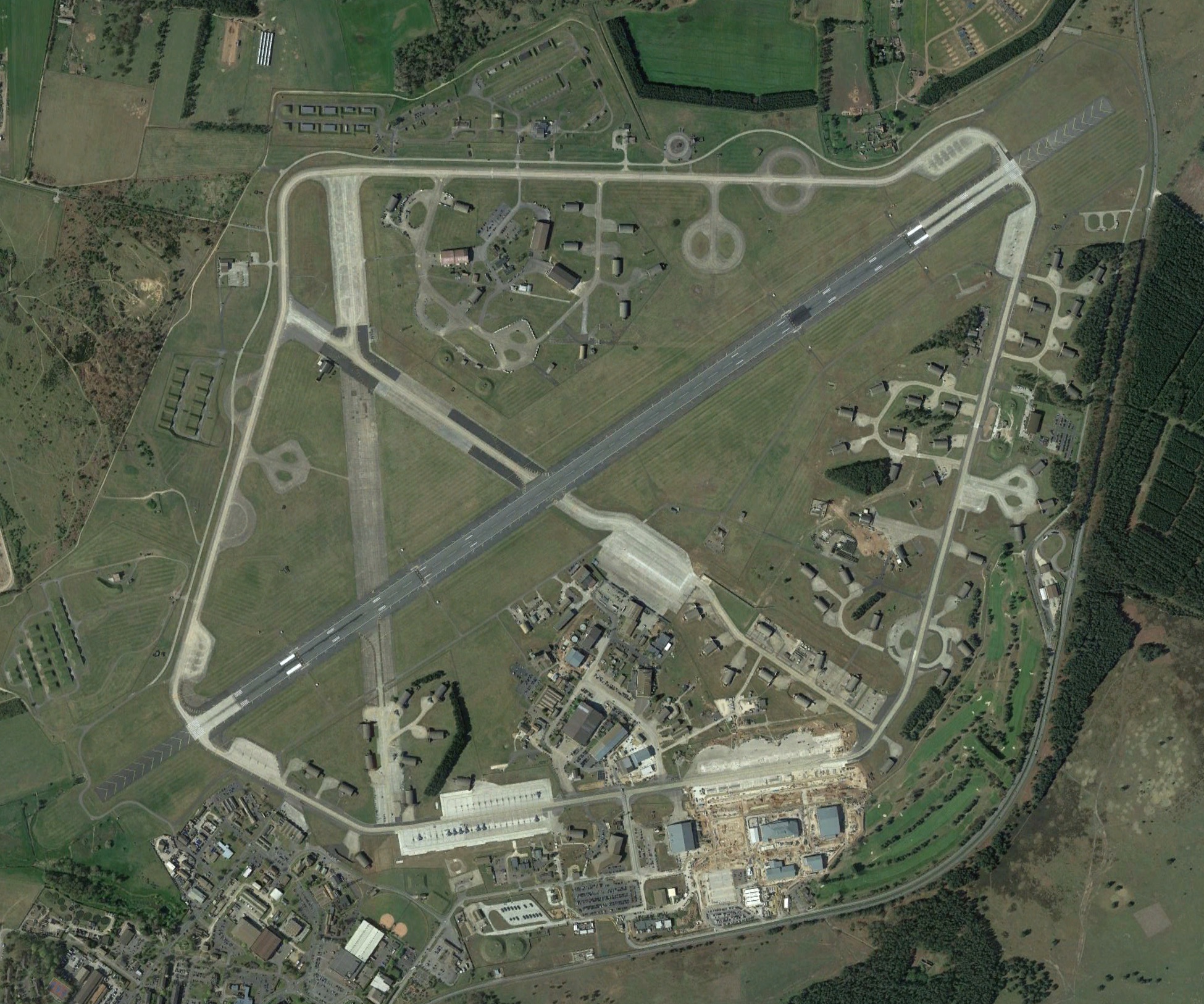
The US Air Force base at Lakenheath has been added to the list of nuclear weapons storage sites being upgraded in Europe.
US Defense Department documents show that NATO has quietly added the United Kingdom to the list of nuclear weapons storage locations that are being upgraded.
The documents do not identify the specific facility, but it is believed to be the US Air Base at RAF Lakenheath in southeast England approximately 100 kilometers northeast of London.
Previous budget documents listed “special weapons” storage sites in Belgium, Germany, Italy, the Netherlands, and Turkey as receiving upgrades under a 13-year NATO investment program. The Biden administration’s FY2023 defense budget request adds “the UK” to the list (see image below).
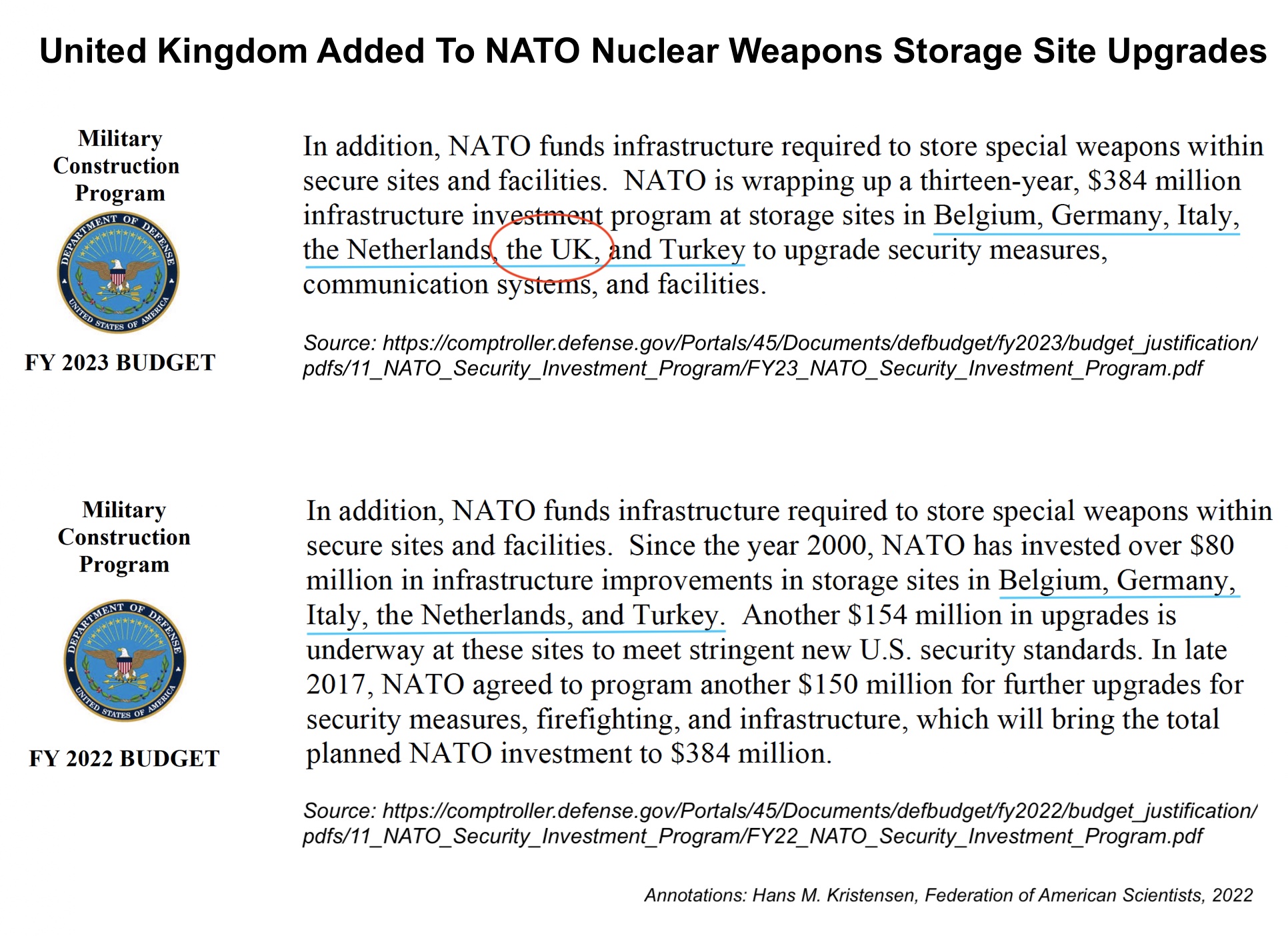
The United Kingdom has been added to the list of nuclear weapons storage site locations in Europe. Click on image to view full size.
RAF Lakenheath was not on the list of “active sites” in the 2016 contract for the upgrade of the nuclear weapons storage site in Europe. The budget documents indicate the base has since been added to the list.
The US Air Force used to store nuclear gravity bombs at Lakenheath, which in the 1990s was equipped with 33 underground storage vaults. By the early 2000s, there were a total of 110 B61 gravity bombs in the vaults for delivery by F-15E aircraft of the 48th Fighter Wing.
In 2008, I disclosed that the nuclear weapons had been withdrawn from RAF Lakenheath, the first time since 1954 that the United States did not store nuclear weapons in the United Kingdom.
What’s Going On?
The addition of the United Kingdom to the list of nuclear storage locations being upgraded in Europe signals a change in the nuclear status of RAF Lakenheath. It is unclear if nuclear weapons have been returned to the base yet or NATO is upgrading the base to be capable of receiving nuclear weapons in the future if necessary.
After nuclear weapons were withdrawn nearly two decades ago, the empty storage vaults were kept in caretaker status. The F-15Es fighter-bombers retained their nuclear capability but at a lower operational level. In recent years there have been rumors about nuclear exercises at the base.
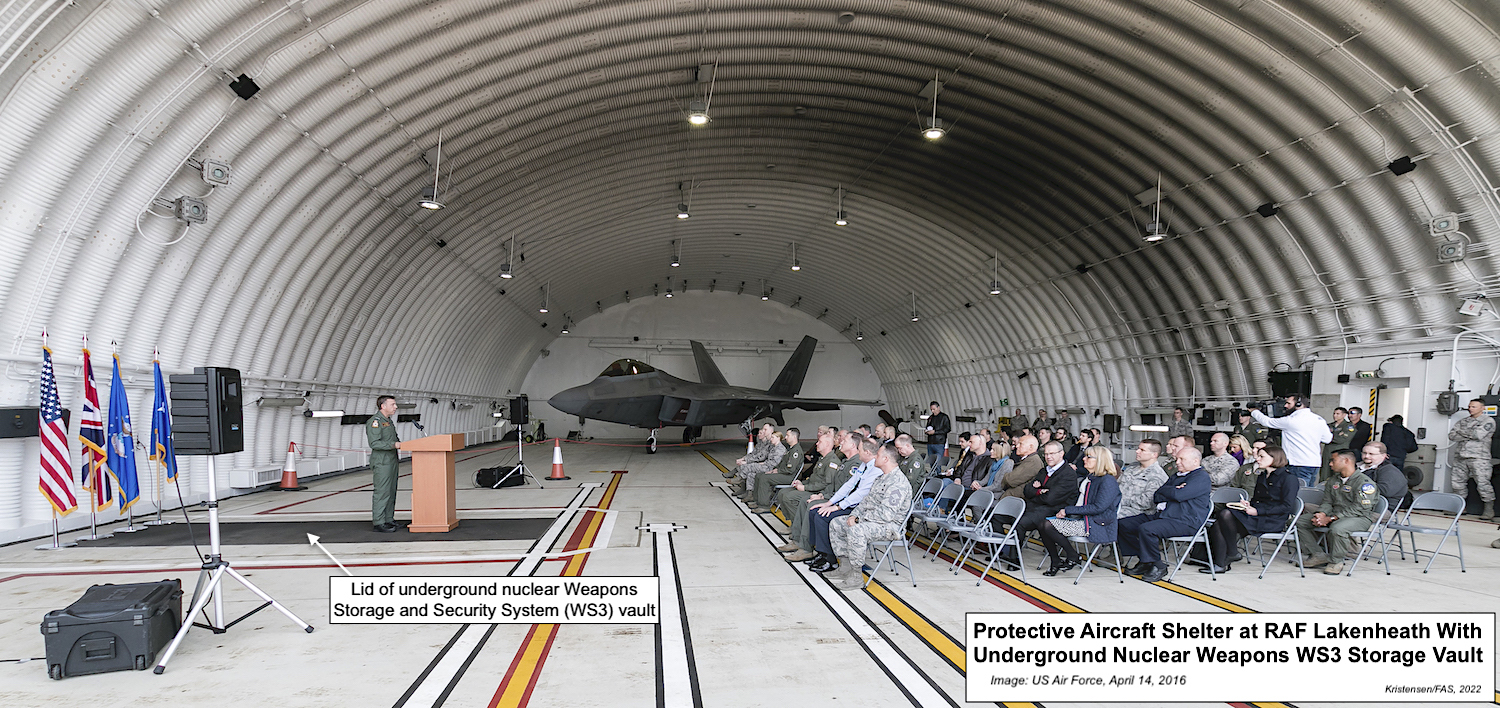
A ceremony during a F-22 Raptor visit to RAF Lakenheath in 2016 was held inside an aircraft shelter with an (empty) underground nuclear weapons vault. There are 33 vaults at the base.
The nuclear upgrade comes as RAF Lakenheath is preparing to become the first US Air Force base in Europe equipped with the nuclear-capable F-35A Lightning. The first of the fifth-generation fighter-bombers arrived in December 2021. A total of 24 F-35As will form the 495th Fighter Squadron of the 48th Fighter Wing at the base.
The US Air Force is scheduled to begin training the nuclear units in Europe within the next year to receive the new B61-12 guided nuclear bomb that will begin full-scale production next month. It is possible the first B61-12 bombs will be shipped to Europe in 2023, where they will replace the B61-3/-4 bombs currently deployed there.

The US will begin full-scale production of the new B61-12 guided nuclear bomb next month, start training units in Europe around the turn of the year, and potentially deploy the first weapons in 2023.
Given NATO’s cautious nuclear response to Russia’s nuclear saber rattling at the start of its invasion of Ukraine, it would be odd if the nuclear upgrade at RAF Lakenheath reflected plans to deploy additional US nuclear bombs to Europe. FAS estimates there currently are roughly 100 nuclear bombs deployed at six air bases in five European countries.
NATO Secretary General Jens Stoltenberg declared in December 2021, that “we have no plans of stationing any nuclear weapons in any other countries than we already have these nuclear weapons as part of our deterrence and that… have been there for many, many years.” Unless NATO has changed its plans since, that seems to be a clear signal that there are currently no plans to deploy nuclear weapons to RAF Lakenheath for now (see map below).

RAF Lakenheath has been an inactive nuclear weapons storage site for nearly two decades. There are currently an estimated 100 US Air Force nuclear bombs stored in Europe.
Rather, the upgrade at RAF Lakenheath could potentially be intended to increase the flexibility of the existing nuclear deployment within Europe, without increasing the number of weapons. Adding RAF Lakenheath as an active site would potentially allow it to receive nuclear weapons from other existing locations in Europe, if that became necessary. Such a contingency could potentially involve receiving weapons withdrawn from Turkey. There are unconfirmed rumors that many of the weapons at Incirlik Air Base in Turkey have already been withdrawn and moved to other bases in Europe.
Readying RAF Lakenheath could potentially also be intended to better realign the overall nuclear posture in Europe with the rapidly deteriorating relations with Russia. This is a delicate issue because changes in NATO’s nuclear posture in Europe might trigger retaliatory changes in Russia’s nuclear posture, including potentially deployment of nuclear weapons to Belarus, which recently changed its constitution to allow for just that.
This publication was made possible by generous support from the John D. and Catherine T. MacArthur Foundation, the New Land Foundation, the Ploughshares Fund, and the Prospect Hill Foundation. The statements made and views expressed are solely the responsibility of the author.
British Defense Review Ends Nuclear Reductions Era
[Article updated May 11, 2021] The United Kingdom announced yesterday that it has decided to abandon a previous plan to reduce it nuclear weapons stockpile to 180 by the mid-2020s and instead “move to an overall nuclear weapon stockpile of no more than 260 warheads.”
The decision makes Britain the first Western nuclear-armed state to increase its nuclear weapons stockpile since the end of the end of the Cold War. In terms of numbers, it takes Britain back to a stockpile size it had in the early-2000s. The change is part of “a shift to a more robust position on security and deterrence.”
The Review also decided that Britain will “no longer give public figures for our operational stockpile, deployed warhead or deployed missile numbers.” This counterproductive decision follows the earlier decision of the Trump administration to keep the nuclear stockpile number secret. By embracing nuclear secrecy, Britain effectively abdicates its ability to criticize Chinese or Russian secrecy about their nuclear arsenals.
The decision to increase the size of the future stockpile – and potentially deploy more warheads on British submarines – is but the latest example of nuclear-armed states invigorating a nuclear arms race and reversing progress toward reducing the world’s nuclear arsenals.
The British Nuclear Weapons Stockpile
The British government has never declassified the history of its nuclear weapons stockpile. Instead, it has occasionally published documents or made statements that gave overall numbers or percentages. The government announced in 2010 that it would have “no more than 225” warheads and later that the limit would be reduced to 180 by the mid-2020s. It is unknown how far the reduction of those approximately 45 warheads has progressed. If spread out evenly over the 15 years, the number might have reached just below 200 by now. But it is highly uncertain so illustrating the British stockpile comes with considerable uncertainty (In this article we conclude that the stockpile did not drop below the 225 ceiling set in 2010 and remains at that level today). The following graph is illustrative and based on previous statements and documents.

Note: This graph has been updated. The history of the United Kingdom nuclear weapons stockpile is still classified, so the graph is provided for illustrative purposes. Click on graph to view full size.
The timeline for the new stockpile limit of 260 warheads is not entirely clear but appears to be during the 2020s. The Review reflects an assessment out to 2030 but “establishes the Government’s overarching national security and international policy objectives, with priority actions, to 2025.”
The wording of the new warhead level is vague. The Review sets the number at “no more than 260 warheads.” The British government has subsequently explained the “260 figure is a ceiling, not a target.” Political damage control is probably part of that statement, but the number could potentially be somewhat lower – or it could be about 260.
Not all of the stockpiled warheads are deployed. The majority is called “operationally available,” which means they’re onboard three of the four SSBNs or can be loaded fairly quickly. The rest are a reserve as spares or undergoing maintenance. Since 2015, the number of “operationally available warheads” has been approximately 120, of which the number deployed on the single SSBN at sea has been reduced to 40.
Unlikely previous defense reviews, the Integrated Review does not include any information about how many of the stockpiled warheads will be operationally available, loaded onboard deployed submarines, or how many submarines will be at sea at any given time. This is a step back for British nuclear transparency. Based on statements from previous governments, however, the number of operationally available warheads under the Johnson posture might end up being similar to what it was during the Blair government: perhaps close to 160 warheads.
The stockpiled warheads that are not “operationally available” are likely stored at Coulport Ammunition Depot nearly the Faslane Submarine Base in Scotland (see image below). Warheads undergoing maintenance or upgrade to the Mk4A aeroshell are probably stored at AWE Burghfield or AWE Aldermaston west of London. Retired warheads are shipped to Burghfield for dismantlement and disposition.
In 2013, the UK government described the process: warheads “yet to be disassembled” are stored at Coulport or as “work in progress” at Burghfield. “A number of warheads identified in the [stockpile reduction] programme for reduction have been modified to render them unusable whilst others identified as no longer being required for service are currently stored and have not yet been disabled or modified.”
Those retired warheads that have not been “rendered unusable” are most likely the source for increasing the stockpile now. Britain doesn’t have the capacity to quickly produce 50-60 new warheads so it simply brings warheads out of retirement. Reconstituting those warheads can probably be done in a few years.
Nuclear Strategy and Targeting
The extent to which the increased stockpile will affect targeting requirement for Britain’s ballistic missile submarines remains to be seen. But the Review states that the stockpile increase comes in response to “the evolving security environment, including the developing range of technological and doctrinal threats.”
Russia is singled out as “the most acute direct threat to the UK” but the Review also contains what appears to be a subtle but clear nuclear threat against Iran (even though it doesn’t have nuclear weapons). After assuring the “UK will not use, or threaten to use, nuclear weapons against any non-nuclear weapon state party to the Treaty on the Non-Proliferation of Nuclear Weapons 1968 (NPT),” the Review adds: “This assurance does not apply to any state in material breach of those non-proliferation obligations.”
The difference between the stockpile limit number and operationally deployed warheads in previous government statements indicates that an increased stockpile limit of 260 warheads most likely will also result in an increase in the number of operationally available warheads and possibly the number of warheads onboard the submarines. An increased number of deployed warheads means an increased number of aimpoints. The United States shares strategic war plan details with the United Kingdom in support of NATO.
In 1998, there were fewer than 200 operationally available warheads. In 2007, that category was reduced to 160 warheads, of which 48 were onboard the submarine at sea. In 2015, that category was reduced to 120 warheads, of which 40 were onboard the single submarine on patrol. The Review states that “at least one [submarine] will always be on a Continuous At Sea Deterrent patrol” (CASD) “at several days’ notice to fire…to guarantee that the UK’s nuclear deterrent remains credible and effective against the full range of state nuclear threats from any direction.”
Perhaps the increased stockpile is intended to facilitate increased targeting of Russia. Perhaps it broadens targeting to other potential adversaries (China, Iran). Perhaps it increases targeting of non-nuclear strategic threats. Perhaps it’s a combination.
The US Connection
The British announcement to increase its stockpile is particularly sensitive now because it preempts the new Biden administration’s upcoming nuclear posture review. Given the nuclear developments in Russia and China, it already seemed unlikely that Biden would reduce the US stockpile further than previously planned. But nuclear proponents in the United States must be rejoicing; the British announcement makes it politically awkward for the Biden administration to reduce.
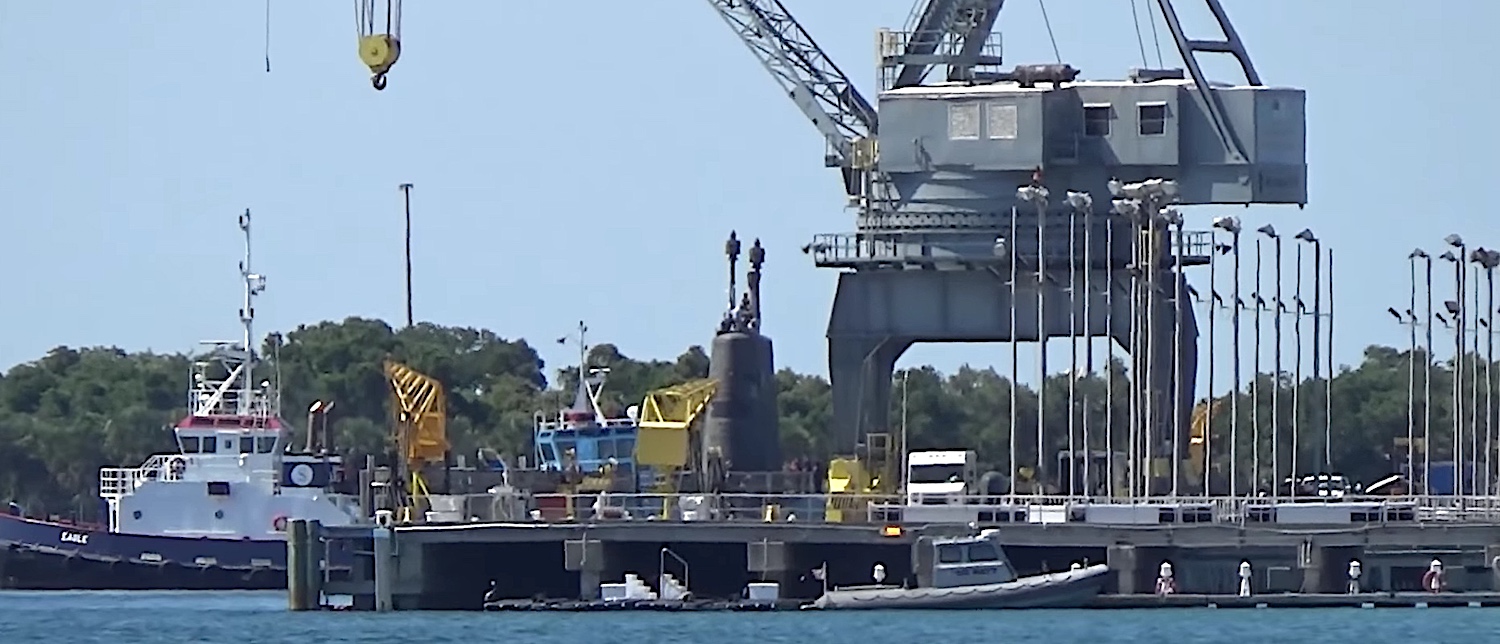
Britain does not own its own ballistic missiles but leases U.S. Trident II D5 missiles. British SSBNs conduct test flights off Florida after being serviced at Port Canaveral.
The current British warhead, known as the Holbrook, is thought to closely resemble the U.S. W76-0. The British warhead is so similar that it is part of the U.S. Department of Energy’s “W76 Needs” maintenance schedule. The Holbrook warhead is currently being backfitted with the new Mk4A aeroshell with enhanced targeting capability. Increasing the stockpile presumably will require buying additional Mk4A aeroshells from the United States.
But the Holbrook is getting old, so British officials have been busy lobbying the U.S. government about moving forward with its proposed new W93/Mk7 warhead, which will also form part of Britain’s next warhead design. Although a U.S. defense official has described the two programs as “two independent, development systems,” a British defense official subsequently explained that although they are “not exactly the same warhead…there is a very close connection in design terms and production terms.” Like the Holbrook, which is contained in the U.S. produced Mk4A reentry body, the new British warhead will be contained in the U.S. produced Mk7 reentry body.
It sounds like we can look forward to another 30 years of discussion about how independent the British deterrent is.
The NPT Context
The decision to increase the nuclear weapons stockpile strongly conflicts with the role Britain has played in nuclear disarmament efforts and the nuclear Nonproliferation Treaty (NPT) regime over the past three decades. All those efforts have been about reducing arsenals. The Review breaks with that legacy.
Nonetheless, the Review reiterates long-held British support for the NPT: “We remain committed to the long-term goal of a world without nuclear weapons. We continue to work for the preservation and strengthening of effective arms control, disarmament and non-proliferation measures, taking into account the prevailing security environment. We are strongly committed to full implementation of the NPT in all its aspects, including nuclear disarmament…” In fact, the commitment to NPT as an instrument for disarmament is so singular that the Review states that “there is no credible alternative route to nuclear disarmament.”
Although NPT’s Article VI does not explicitly prohibit Britain from increasing its nuclear stockpile, it obligates Britain to “pursue negotiations in good faith on effective measures relating to cessation of the nuclear arms race at an early date and to nuclear disarmament, and on a treaty on general and complete disarmament under strict and effective international control.”
Increasing the stockpile in response to Russia and other threats certainly seems to conflict with the goal of ending the nuclear arms race. Instead, it seems to embrace a race.
Moreover, British governments have explicitly linked stockpile reductions to its “obligations under Article six.” In 2015, for example, the U.K. delegation to the NPT Review Conference stated that the “United Kingdom remains firmly committed to step-by-step disarmament, and our obligations under Article Six. We announced in January that we have reduced the number of warheads on each of our deployed ballistic missile submarines from 48 to 40, and the number of operational missiles on each of those submarines to no more than eight.”
The decision to increase the stockpile clearly contradicts those assurances and obligations. That, and the decision to reduce nuclear transparency, will make it less credible for British diplomats to criticize Russia and China for increasing their stockpiles and hiding behind nuclear secrecy. It might also weaken Britain’s ability to appeal to Iran not to develop nuclear weapons.
In conclusion: Johnson has pulled a Trumpie that will boost Britains nuclear profile but do little to reduce nuclear dangers.
Additional information: United Kingdom Nuclear Weapons, 2021
This publication was made possible by generous support from the John D. and Catherine T. MacArthur Foundation, the New Land Foundation, the Ploughshares Fund, and the Prospect Hill Foundation. The statements made and views expressed are solely the responsibility of the author.
Nuclear Transparency and the Stockpile Stewardship and Management Plan
 By Hans M. Kristensen
By Hans M. Kristensen
I was reading through the latest Stockpile Stewardship and Management Plan from the National Nuclear Security Administration (NNSA) and wondering what I should pick to critique the Obama administration’s nuclear policy.
After all, there are plenty of issues that deserve to be addressed, including:
– Why NNSA continues to overspend and over-commit and create a spending bow wave in 2021-2026 in excess of the President’s budget in exactly the same time period that excessive Air Force and Navy modernization programs are expected to put the greatest pressure on defense spending?
– Why a smaller and smaller nuclear weapons stockpile with fewer warhead types appears to be getting more and more expensive to maintain?
– Why each warhead life-extension program is getting ever more ambitious and expensive with no apparent end in sight?
– And why a policy of reductions, no new nuclear weapons, no pursuit of new military missions or new capabilities for nuclear weapons, restraint, a pledge to “put an end to Cold War thinking,” and the goal of disarmament, instead became a blueprint for nuclear overreach with record funding, across-the-board modernizations, unprecedented warhead modifications, increasing weapons accuracy and effectiveness, reaffirmation of a Triad and non-strategic nuclear weapons, continuation of counterforce strategy, reaffirmation of the importance and salience of nuclear weapons, and an open-ended commitment to retain nuclear weapons further into the future than they have existed so far?
What About The Other Nuclear-Armed States?
Despite the contradictions and flaws of the administration’s nuclear policy, however, imagine if the other nuclear-armed states also published summaries of their nuclear weapons plans. Some do disclose a little, but they could do much more. For others, however, the thought of disclosing any information about the size and composition of their nuclear arsenal seems so alien that it is almost inconceivable.
Yet that is actually one of the reasons why it is necessary to continue to work for greater (or sufficient) transparency in nuclear forces. Some nuclear-armed states believe their security depends on complete or near-compete nuclear secrecy. And, of course, some nuclear information must be protected from disclosure. But the problem with excessive secrecy is that it tends to fuel uncertainty, rumors, suspicion, exaggerations, mistrust, and worst-case assumptions in other nuclear-armed states – reactions that cause them to shape their own nuclear forces and strategies in ways that undermine security for all.
Nuclear-armed states must find a balance between legitimate secrecy and transparency. This can take a long time and it may not necessarily be the same from country to country. The United States also used to keep much more nuclear information secret and there are many institutions that will always resist public access. But maximum responsible disclosure, it turns out, is not only necessary for a healthy public debate about nuclear policy, it is also necessary to communicate to allies and adversaries what that policy is about – and, equally important, to dispel rumors and misunderstandings about what the policy is not.
Nuclear transparency is not just about pleasing the arms controllers – it is important for national security.
So here are some thoughts about what other nuclear-armed states should (or could) disclose about their nuclear arsenals – not to disclose everything but to improve communication about the role of nuclear weapons and avoid misunderstandings and counterproductive surprises:
 Russia should publish:
Russia should publish:
– Full New START aggregate data numbers (these numbers are already shared with the United States, that publishes its own numbers)
– Size and history of overall nuclear weapons stockpile
– Number of history of nuclear warhead dismantlement (has made statements about percentage reductions since 1991 but not disclosed numbers or history)
– Basic overview of which nuclear forces are nuclear-capable (has made some statements about strategic forces but not shorter-range forces)
– Plans for future years force levels of long-range nuclear forces (has made occasional statements about modernizations but no detailed plan)
– Overall status and out-year budgets for nuclear weapons and nuclear forces
 China should publish:
China should publish:
– Size and history of overall nuclear weapons stockpile (stated in 2004 that it possessed the smallest arsenal of the nuclear weapon states but has not disclosed numbers or history)
– Basic overview of its nuclear-capable forces
– Plans for future years force levels of long-range nuclear forces
– Overall status and out-year budgets for nuclear weapons and nuclear forces
 France should publish:
France should publish:
– History of overall nuclear weapons stockpile (has disclosed the size of its nuclear stockpile in 2008 and 2015 (300 weapons), but not the history)
– Number and history of nuclear warhead dismantlement (has declared dismantlement of some types but not history)
(France has disclosed its overall force structure and some nuclear budget information is published each year.)
 Britain should publish:
Britain should publish:
– History of overall nuclear weapons stockpile (has declared some approximate historic numbers, declared the approximate size in 2010 (no more than 225), and has declared plan for mid-2020s (no more than 180), but has not disclosed history)
– Number and history of nuclear warhead dismantlement (has announced dismantlement of systems but not numbers or history)
(Britain has published information about the size of its nuclear force structure and part of its nuclear budget.)
 Pakistan should publish:
Pakistan should publish:
– History of overall nuclear weapons stockpile
– Basic overview of nuclear-capable forces (occasionally declares that a missile test involves nuclear-capable weapon)
– Plans for future years force levels of longer-range nuclear forces
– Overall status and out-year budgets for nuclear weapons and nuclear forces
 India should publish:
India should publish:
– History of overall nuclear weapons stockpile
– Basic overview of nuclear-capable forces (occasionally declares that a missile test involves nuclear-capable weapon)
– Plans for future years force levels of longer-range nuclear forces
– Overall status and out-year budgets for nuclear weapons and nuclear forces
 Israel should publish:
Israel should publish:
…or should it? Unlike other nuclear-armed states, Israel has not publicly confirmed it has a nuclear arsenal and has said it will not be the first to introduce nuclear weapons in the Middle East. Some argue Israel should not confirm or declare anything because of fear it would trigger nuclear arms programs in other Middle Eastern countries.
On the other hand, the existence of the Israeli nuclear arsenal is well known to other countries as has been documented by declassified government documents in the United States. Official confirmation would be politically sensitive but not in itself change national security in the region. Moreover, the secrecy fuels speculations, exaggerations, accusations, and worst-case planning. And it is hard to see how the future of nuclear weapons in the Middle East can be addressed and resolved without some degree of official disclosure.
 North Korea should publish:
North Korea should publish:
Well, obviously this nuclear-armed state is a little different (to put it mildly) because its blustering nuclear threats and statements – and the nature of its leadership itself – make it difficult to trust any official information. Perhaps this is a case where it would be more valuable to hear more about what foreign intelligence agencies know about North Korea’s nuclear arsenal. Yet official disclosure could potentially serve an important role as part of a future de-tension agreement with North Korea.
Additional information:
Status of World Nuclear Forces with links to more information about individual nuclear-armed states.
“Nuclear Weapons Base Visits: Accident and Incident Exercises as Confidence-Building Measures,” briefing to Workshop on Non-Strategic Nuclear Weapons in Europe: Transparency and Confidence-Building Measures in Practice, German Institute for International and Security Affairs, Berlin, 27-28 March 2014.
“Nuclear Warhead Stockpiles and Transparency” (with Robert Norris), in Global Fissile Material Report 2013, International Panel on Fissile Materials, October 2013, pp. 50-58.
The research for this publication was made possible by a grant from the New Land Foundation, and Ploughshares Fund. The statements made and views expressed are solely the responsibility of the author.
Nuclear Modernization Briefings at the NPT Conference in New York

By Hans M. Kristensen
Last week I was in New York to brief two panels at the Third Session of the Preparatory Committee for the 2015 Review Conference of the Parties to the Treaty on the Non-Proliferation of Nuclear Weapons (phew).
The first panel was on “Current Status of Rebuilding and Modernizing the United States Warheads and Nuclear Weapons Complex,” an NGO side event organized on May 1st by the Alliance for Nuclear Accountability and the Women’s International League for Peace and Freedom (WILPF). While describing the U.S. programs, I got permission from the organizers to cover the modernization programs of all the nuclear-armed states. Quite a mouthful but it puts the U.S. efforts better in context and shows that nuclear weapon modernization is global challenge for the NPT.
The second panel was on “The Future of the B61: Perspectives From the United States and Europe.” This GNO side event was organized by the Nuclear Age Peace Foundation on May 2nd. In my briefing I focused on providing factual information about the status and details of the B61 life-extension program, which more than a simple life-extension will produce the first guided, standoff nuclear bomb in the U.S. inventory, and significantly enhance NATO’s nuclear posture in Europe.
The two NGO side events were two of dozens organized by NGOs, in addition to the more official side events organized by governments and international organizations.
The 2014 PREPCOM is also the event where the United States last week disclosed that the U.S. nuclear weapons stockpile has only shrunk by 309 warheads since 2009, far less than what many people had anticipated given Barack Obama’s speeches about “dramatic” and “bold” reductions and promises to “put an end to Cold War thinking.”
Yet in disclosing the size and history of its nuclear weapons stockpile and how many nuclear warheads have been dismantled each year, the United States has done something that no other nuclear-armed state has ever done, but all of them should do. Without such transparency, modernizations create mistrust, rumors, exaggerations, and worst-case planning that fuel larger-than-necessary defense spending and undermine everyone’s security.
For the 185 non-nuclear weapon states that have signed on to the NPT and renounced nuclear weapons in return of the promise made by the five nuclear-weapons states party to the treaty (China, France, Russia, United Kingdom, and the United States) “to pursue negotiations in good faith on effective measures relating to the cessation of the nuclear arms race at early date and to nuclear disarmament,” endless modernization of the nuclear forces by those same five nuclear weapons-states obviously calls into question their intension to fulfill the promise they made 45 years ago. Some of the nuclear modernizations underway are officially described as intended to operate into the 2080s – further into the future than the NPT and the nuclear era have lasted so far.
Download two briefings listed above: briefing 1 | briefing 2
This publication was made possible by a grant from the Ploughshares Fund. The statements made and views expressed are solely the responsibility of the author.
Air Force Briefing Shows Nuclear Modernizations But Ignores US and UK Programs
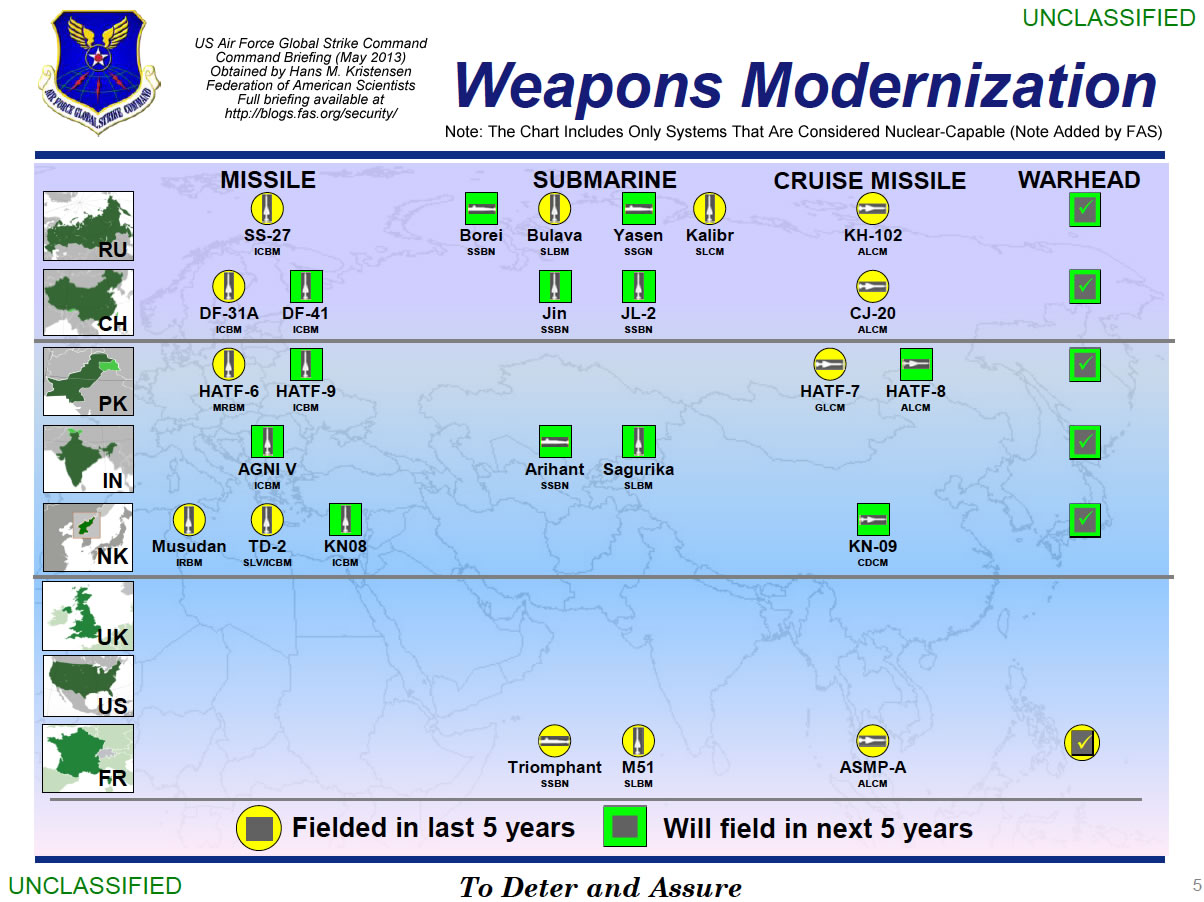
Click to view large version. Full briefing is here.
By Hans M. Kristensen
China and North Korea are developing nuclear-capable cruise missiles, according to U.S. Air Force Global Strike Command (AFGSC).
The new Chinese and North Korean systems appear on a slide in a Command Briefing that shows nuclear modernizations in eight of the world’s nine nuclear weapons states (Israel is not shown).
The Chinese missile is the CJ-20 air-launched cruise missile for delivery by the H-6 bomber. The North Korean missile is the KN-09 coastal-defense cruise missile. These weapons would, if for real, be important additions to the nuclear arsenals in Asia.
At the same time, a closer look at the characterization used for nuclear modernizations in the various countries shows generalizations, inconsistencies and mistakes that raise questions about the quality of the intelligence used for the briefing.
Moreover, the omission from the slide of any U.S. and British modernizations is highly misleading and glosses over past, current, and planned modernizations in those countries.
For some, the briefing is a sales pitch to get Congress to fund new U.S. nuclear weapons.
Overall, however, the rampant nuclear modernizations shown on the slide underscore the urgent need for the international community to increase its pressure on the nuclear weapon states to curtail their nuclear programs. And it calls upon the Obama administration to reenergize its efforts to reduce the numbers and role of nuclear weapons.
Russia
![]()
The briefing lists seven Russian nuclear modernizations, all of which are well known and have been underway for many years. Fielded systems include SS-27 ICBM, Bulava SLBM, Kalibr SLCM, and KH-102 ALCM.
It is puzzling, however, that the briefing lists Bulava SLBM and Kalibr SLCM as fielded when their platforms (Borei SSBN and Yasen SSGN, respectively) are not. The first Borei SSBN officially entered service in January 2013.
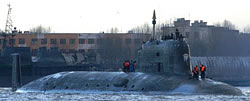
Nuclear Cruise Missile For Yasen SSGN
It is the first time I’ve seen a U.S. government publication stating that the non-strategic Kalibr land-attack SLCM is nuclear (in public the Kalibr is sometimes called Caliber). The first Yasen SSGN, the Severodvinsk, test launched the Kalibr in November 2012. The weapon will also be deployed on the Akula-class SSGN. The Kalibr SLCM, which is dual-capable, will probably replace the aging SS-N-21, which is not. There are no other Russian non-strategic nuclear systems listed in the AFGSC briefing.
A new warhead is expected within the next five years, but since no new missile is listed the warhead must be for one of the existing weapons.
China
![]()
The briefing lists six Chinese nuclear modernizations: DF-31A ICBM, DF-41 ICBM, Jin SSBN, JL-2 SLBM, CJ-20 ALCM, and a new warhead.
The biggest surprise is the CJ-20 ALCM, which is the first time I have ever seen an official U.S. publication crediting a Chinese air-launched cruise missile with nuclear capability. The latest annual DOD report on Chinese military modernization does not do so.
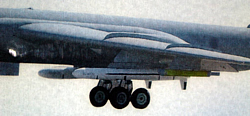
H-6 with CJ-20. Credit: Chinese Internet.
The CJ-20 is thought to be an air-launched version of the 1,500+ kilometer ground-launched CJ-10 (DH-10), which the Air Force in 2009 reported as “conventional or nuclear” (the AFGSC briefing does not list the CJ-10). The CJ-20 apparently is being developed for delivery by a modified version of the H-6 medium-range bomber (H-6K and/or H-6M) with increased range. DOD asserts that the H-6 using the CJ-20 ALCM in a land-attack mission would be able to target facilities all over Asia and Russia (east of the Urals) as well as Guam – that is, if it can slip through air defenses.
The elusive DF-41 ICBM is mentioned by name as expected within the next five years. References to a missile known as DF-41 has been seen on and off for the past two decades, but disappeared when the DF-31A appeared instead. The latest DOD report does not mention the DF-41 but states that, “China may also be developing a new road-mobile ICBM, possibly capable of carrying a multiple independently targetable reentry vehicle (MIRV).” (Emphasis added).
AFGSC also predicts that China will field a new nuclear warhead within the next five years. MIRV would probably require a new and smaller warhead but it could potentially also refer to the payload for the JL-2.
Pakistan
![]()
Pakistan is listed with five nuclear modernizations, all of which are well known: Hatf-8 (Shaheen II) MRBM, Hatf-9 (NASR) SRBM, Hatf-7 (Babur) GLCM, Hatf-8 (Ra’ad) ALCM, and a new warhead. Two of them (Hatf-8 and Hatf-7) are listed as fielded.
The briefing mistakenly identifies the Hatf-9 as an ICBM instead of what it actually is: a short-range (60 km) ballistic missile.
The new warhead might be for the Hatf-9.
India
![]()
India is listed with four nuclear modernizations, all of which are well known: Agni V ICBM, Arihant SSBN, “Sagurika” SLBM, and a new warhead. The U.S. Intelligence Community normally refers to “Sagurika” as Sagarika, which is known as K-15 in India.
Neither the Agni III nor Agni IV are listed in the briefing, which might indicate, if correct, that the two systems, both of which were test launched in 2012, are in fact technology development programs intended to develop the technology to field the Agni V.
The U.S. Intelligence Community asserts that the Agni V will be capable of carrying multiple warheads, as recently stated by an India defense industry official – a dangerous development that could well motivate China to deploy multiple warheads on some of its missiles and trigger a new round of nuclear competition between India and China.
The new warhead might be for the SLBM and/or for Agni V.
North Korea
![]()
North Korea is listed with five nuclear modernizations: Musudan IRBM, TD-2 SLV/ICBM, KN-08 ICBM, KN-09 CDCM, and a warhead.

The biggest surprise is that AFGSC asserts that the KN-09 is nuclear-capable. There are few public reports about this weapon, but the South Korean television station MBC reported in April that it has a range of 100-120 km. MBC showed KN-09 as a ballistic missile, but AFGSC lists it as a CDCM (Coastal Defense Cruise Missile).
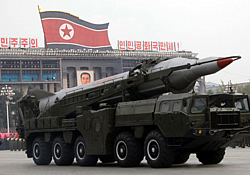
The Musudan IRBM is listed as “fielded” even though the missile, according to the U.S. Intelligence Community, has never been flight tested. In this case, “fielded” apparently means it has appeared but not that it is operational or necessarily deployed with the armed forces.
The Mushudan is listed as “fielded,” similar to the Russian SS-27, even though the North Korean missile has never been flight tested.
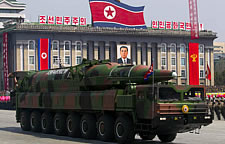
The KN-08 ICBM, which was displayed at the May 2012 parade, was widely seen by non-governmental analysts to be a mockup. But AFGSC obviously believes the weapon is real and expected to be “fielded” within the next five years. There were rumors in January 2013 that North Korea had started moving KN-08 launchers around the country at the beginning of a saber-rattling campaign that lasted through March.
Finally, the AFGSC briefing also predicts that North Korea will field a nuclear warhead within the next five year. Whether this refers to North Korea’s first weaponized warhead or newer types is unclear.
United Kingdom
![]()
The UK section does not include any weapons modernizations, which doesn’t quite capture what’s going on. For example, Britain is deploying the modified W76-1/Mk4A, which British officials have stated will increase the targeting capability of the Trident II D5 SLBM. Accordingly, a warhead icon has been added to the U.K. bar above.
Moreover, although the final approval has not been given yet, Britain is planning construction of a new SSBN to replace the current fleet of four Vanguard-class SSBNs. The missile section is under development in the United States. The new submarine will also receive the life-extended D5 SLBM.
United States
![]()
The U.S. section also does not show any nuclear modernizations, which glosses over important upgrades.
For example, the Minuteman III ICBM is in the final phases of a decade-long multi-billion dollar life-extension program that will extend the weapon to 2030. Privately, Air Force officials are joking that everything except the shell is new. Accordingly, a fielded ICBM icon has been added to the U.S. bar.
Moreover, full-scale production and deployment of the W76-1/Mk4A warhead on the Trident II D5 SLBM is underway. The combination of the new reentry body with the D5 increases the targeting capability of the weapon. Accordingly, a fielded warhead icon has been added to the U.S. bar.
In addition, from 2017 the U.S. Navy will begin deploying a modified life-extended version of the D5 SLBM (D5LE) on Ohio-class SSBNs. Production of the D5LE is currently underway, which will be “more accurate” and “provide flexibility to support new missions,” according to the navy and contractor. Accordingly, a forthcoming SLBM icon has been added to the U.S. bar.
Finally, the United States has begun design of a new SSBN class, a long-range bomber, a long-range cruise missile, a fighter-bomber, a guided standoff gravity bomb, and is studying a replacement-ICBM.
Hardly the dormant nuclear enterprise portrayed in the briefing.
France
![]()
France is listed with four nuclear modernizations, all well known: Triomphant SSBN, M51 SLBM, ASMP-A ALCM, and a new warhead.
The introduction of the ASMP-A is complete but the M51 SLBM is still replacing M45 SLBMs on the SSBN fleet.
The warhead section only appears to include the TNA warhead for the ASMP-A but ignores that France from 2015 will begin replacing the TN75 warhead on the M51 SLBM with the new TNO.
What is Meant by Nuclear and Fielded?
The AFGSC briefing is unclear and somewhat confusing about what constitutes a nuclear-capable weapon system and when it is considered “fielded.”
AFGSC confirmed to me that the slide only lists nuclear-capable weapon systems.
Air Force regulations are pretty specific about what constitutes a nuclear-capable unit. According to Air Force Instruction 13-503 regarding the Nuclear-Capable Unit Certification, Decertification and Restriction Program, a nuclear-capable unit is “a unit or an activity assigned responsibilities for employing, assembling, maintaining, transporting or storing war reserve (WR) nuclear weapons, their associated components and ancillary equipment.”
This is pretty straightforward when it comes to Russian weapons but much more dubious when describing North Korean systems. Russia is known to have developed miniaturized warheads and repeatedly test-flown them on missiles that are operationally deployed with the armed forces.
North Korea is a different matter. It is known to have detonated three nuclear test devices and test-launched some missiles, but that’s pretty much the extent of it. Despite its efforts and some worrisome progress, there is no public evidence that it has yet turned the nuclear devices into miniaturized warheads that are capable of being employed successfully by its ballistic or cruise missiles. Nor is there any public evidence that nuclear-armed missiles are operationally deployed with the armed forces.
Moreover, the U.S. Intelligence Community has recently issued strong statements that cast doubt on whether North Korea has yet mastered the technology to equip missile with nuclear warheads. James Clapper, the director of National Intelligence, testified before the Senate on April 18, 2013, that despite its efforts, “North Korea has not, however, fully developed, tested, or demonstrated the full range of capabilities necessary for a nuclear-armed missile.”
So how can the AFGSC briefing label North Korean ballistic missiles as nuclear-capable – and also conclude that the KN-09 cruise missile is nuclear-capable?
There are similar questions about the determination of when a weapon system is “fielded.” Does it mean it is fielded with the armed forces or simply that it has been seen? For example, how can a North Korean Musudan IRBM be considered fielded similarly to a Russia SS-27 ICBM?
Or how can the Musudan IRBM be identified as already “fielded” when it has not been flight tested and only displayed on parade, when the KN-08 is identified as not “fielded” even though it has also not been flight tested, also been displayed on parade, and even moved around North Korea?
Finally, how can the Russian Bulava SLBM and Kalibr SLCM be listed as “fielded” when their delivery platforms (Borei SSBN and Yasen SSGN, respectively) are listed as not fielded?
These inconsistencies cast doubt on the quality of the AFGSC briefing and whether it represents the conclusion of a coordinated Intelligence Community assessment, or simply is an effort to raise money in Congress for modernizing U.S. bombers and ICBMs.
Implications and Recommendations
There are still more than 17,000 nuclear weapons in the world and all the nuclear weapon states are busy maintaining and modernizing their arsenals. After Russia and the United States have insisted for decades that nuclear cruise missiles are essential for their security, the AFGSC briefing claims that China and North Korea are now trying to follow their lead.
For some, the AFGSC briefing will be (and probably already is) used to argue that nuclear threats against the United States and its allies are increasing and that Congress therefore should oppose further reductions of U.S. nuclear forces and instead approve modernizations of the remaining arsenal.
But Russia is not expanding its nuclear forces, the nuclear arsenals of China and Pakistan are much smaller than U.S. forces, and North Korea is in its infancy as a nuclear weapon state.
Instead, the rampant nuclear modernizations shown in the briefing symbolize struggling arms control and non-proliferation regimes that appear inadequate to turn the tide. They are being undercut by recommitments of a small group of nuclear weapon states to retain and improve nuclear forces for the indefinite future. The modernizations are partially being sustained by non-nuclear weapon states – often the very same who otherwise say they want nuclear disarmament – that insist on being protected by nuclear weapons.
The AFGSC briefing shows that there’s an urgent need for the international community to increase its pressure on the nuclear weapon states to curtail their nuclear programs. Especially limitations on MIRVed missiles are urgently needed. For its part, the Obama administration must reenergize its efforts to reduce the numbers and role of nuclear weapons.
There have been many nice speeches about reducing nuclear arsenals but too little progress on limiting the endless cycle of modernizations that sustain them.
Document: Air Force Global Strike Command Command Briefing
This publication was made possible by grants from the New-Land Foundation and Ploughshares Fund. The statements made and views expressed are solely the responsibility of the author.
PREPCOM Nuclear Weapons De-Alerting Briefing

By Hans M. Kristensen
Greetings from Geneva! I’m at the Palais des Nations for the second Preparatory Committee (PREPCOM) meeting for the 2015 Review Conference of the nuclear Non-Proliferation Treaty (NPT). I was invited by the Swiss and New Zealand UN Missions to brief our report Reducing Alert Rates of Nuclear Weapons.
With me on the panel was Richard Garwin, an FAS board member who for more than five decades has advised U.S. governments on nuclear weapons and other issues, and Gareth Evans, former Australian Foreign Minister and now Chancellor of the Australian National University.
The panel was co-chaired by Ambassador H.E. Dell Higgie, the head of the New Zealand UN Mission and Permanent Representative to the United Nations and Conference on Disarmament, and Ambassador Benno Laggner, the head of the Swiss Foreign Ministry’s Division for Security Policy and Ambassador for Nuclear Disarmament and Non-Proliferation. Switzerland and New Zealand have for several years spearheaded efforts in the United Nations to reduce the alert level of nuclear weapons.
I wrote the de-alerting report together with Matthew McKinzie who directs the nuclear program at the Natural Resources Defense Council. Click to download my briefing slides (7.6 MB) and prepared remarks.
New Report: Reducing Alert Rates of Nuclear Weapons
.By Hans M. Kristensen
The United States and Russia have some 1,800 nuclear warheads on alert on ballistic missiles that are ready to launch in a few minutes, according to a new study published by UNIDIR. The number of U.S. and Russian alert warheads is greater than the total nuclear weapons inventories of all other nuclear weapons states combined.
The report Reducing Alert Rates of Nuclear Weapons is co-authored by Matthew McKinzie from the Natural Resources of Defense Council and yours truly.
France and Britain also keep some of their nuclear force on alert, although at lower readiness levels than the United States and Russia. No other nuclear weapon state has nuclear weapons on alert.
The report concludes that the warning made by opponents of de-alerting, that it could trigger a re-alerting race in a crisis that count undermine stability, is a “straw man” argument that overplays risks, downplays benefits, and ignores that current alert postures already include plans to increase readiness and alert rates in a crisis.
According to the report, “while there are risks with alerted and de-alerted postures, a re-alerting race that takes three months under a de-alerted posture is much preferable to a re-alerting race that takes only three hours under the current highly alerted posture. A de-alerted nuclear posture would allow the national leaders to think carefully about their decisions, rather than being forced by time constraints to choose from a list of pre-designated responses with catastrophic consequences.”
During his election campaign, Barack Obama promised to work with Russia to take nuclear weapons off “hair-trigger” alert, but the 2010 Nuclear Posture Review (NPR) instead decided to keep the existing alert posture. The post-NPR review that has now been completed but has yet to be announced hopefully will include a reduction of the alert level, not least because the Intelligence Community has concluded that a Russian surprise first strike is unlikely to occur.
The UNIDIR report finds that the United States and Russia previously have reduce the alert levels of their nuclear forces and recommends that they continue this process by removing the remaining nuclear weapons from alert through a phased approach to ensure stability and develop consultation and verification measures.
Full report: Reducing Alert Rates of Nuclear Weapons (FAS mirror)
This publication was made possible by a grant from the Swiss Government. General nuclear forces research is supported by the Ploughshares Fund. The statements made and views expressed are solely the responsibility of the authors.

